-
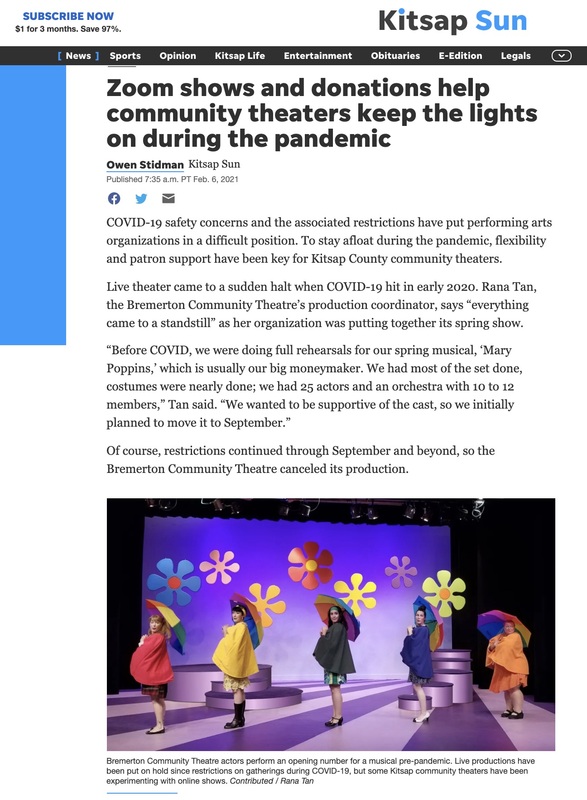
2021-02-06
With Covid-19 shutting down live performances all over the world, community theaters have been struggling to pay their bills without the income from ticket sales. Because of this, many have turned to Zoom shows and donations so that they can stay afloat until it is safe to hold live performances again. Community theaters are necessary to keep the performing arts alive in small towns and rural areas, but they often receive less grant support than larger theaters and performing arts centers, so they often rely on the support of their patrons. Hopefully virtual performances and fundraisers can keep these theaters alive, so these smaller communities don't lose all access to live theater and performing arts.
-
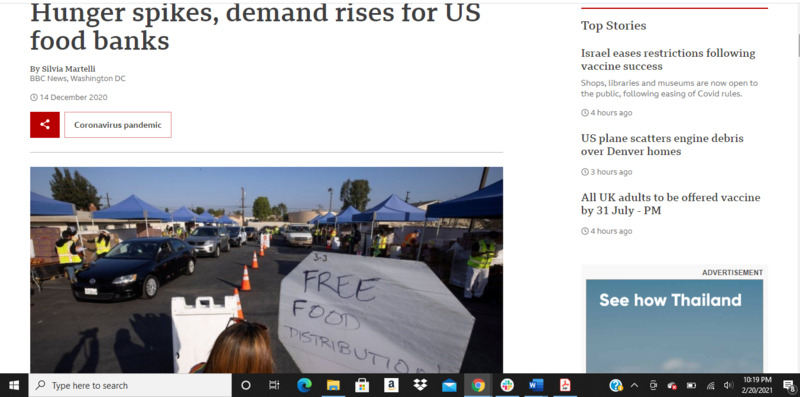
2021-02-07
The numbers of people with food insecurities in 2020 include some scary statistics. The BBC wrote that one in eight Americans didn’t have enough food in the month of November, 2020. Feeding America said one in every six Americans would face food insecurity. Some people are getting creative, like a food bank in Illinois that started out online, providing a sort of online grocery shopping, but for free.
Hunger has been a world-wide problem for a long time, and is something I would like to see ended in my life time. However, during this pandemic, when many more people began facing economic hardships, we see different outcomes. Some people are trying to make changes and help more vulnerable people, like some of the stories you can find on foodbanknews.org. Unfortunately, there are still many people facing the fact that they do not know when their next meal will come from. It isn’t a food problem, it is a society problem.
-
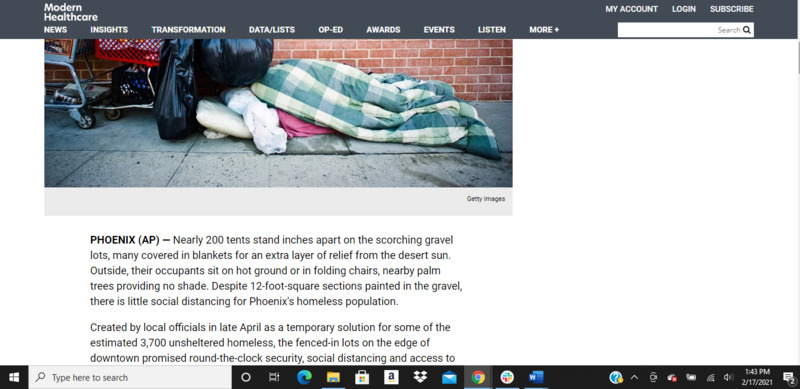
2021-02-07
A population that gets put last for many things is not going to be completely last for the COVID vaccine. Each individual US state is in charge of the vaccine distribution, but some states, like Connecticut for example, have homeless shelters and similar places under the “congregate settings” part of the vaccine rollout, typically in the first few phases. The homeless population is far too high in the US, and during the COVID pandemic, not much more than the bare minimum has been done. The CDC and many other health organizations have the homeless and other vulnerable populations written into the big picture, with guides and recourses for cities and governments. However, these vulnerable populations are high risk during this pandemic. Food banks have seen a major rise in 2020 as more people are facing economic hardships.
Attached are a few related articles. While there are some people working tirelessly to improve the homeless situation in the US, more needs to be done. The articles give a glimpse into the various aspects of the homeless crisis in America, and how we are trying to help during the pandemic, but simultaneously not doing enough.
-
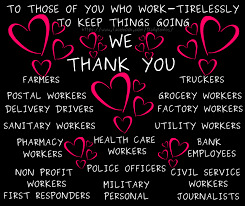
2021-02-07
Perhaps, it is an American phenomenon. People refusing to wear masks in public places, even when face to face with an “essential worker.” At the start of the pandemic in the United States, when people were closing their doors and staying home, there became a flurry of conversations about essential workers, the people who couldn’t stay home, in order to keep society as we know it flowing. Hospital workers, fighting the unknown; the service industry, continuing to feed and care for people; factory workers and truckers, delivering the stuff people staying home needed, all essential. Unfortunately, there is an ongoing battle that effects everyone: people refusing to wear masks. Some in the medical industry, especially the ones helping COVID patients fight for their life, feel like it is a slap in the face. People in the service industry have to decide between asking somebody to put on a mask and risking being verbally or physically attacked by the person, or risking their own health.
I have added a few sources. First, some memes and pictures, thanking essential workers. There is an article from Forbes on how to deal with customers who will not wear a mask. I’ve added a BBC article on why Americans don’t wear masks, but also an article from The Indian Express that shows anti-mask protests in multiple countries.
Masks are a pretty simple addition to our lives. Of course, they take a while to get used to, and still leave me sweaty. While they are not a solution for completely stopping the spread of COVID, they do make a difference, and should be taken seriously. The sources I’ve attached tell a small part of the story of how humans have reacted to this pandemic.
-
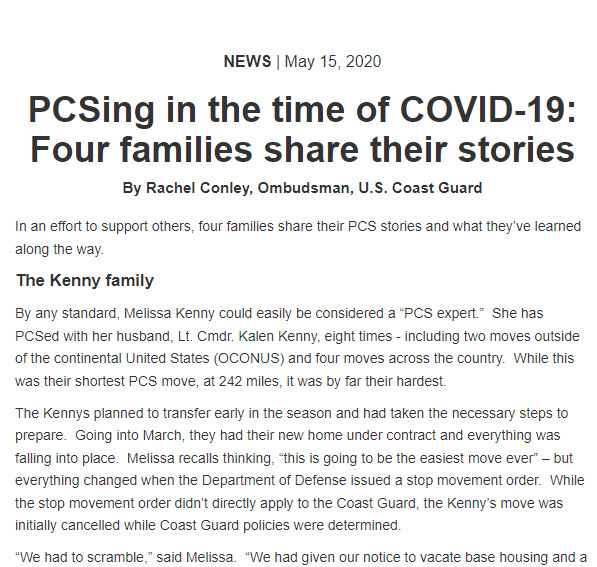
2020-05-15
This story follows four military families as they prepare for Permanent Change of Station (PCS) orders. The process is further complicated due to COVID-19 restrictions. Each family shares how they had to adjust routine travel plans; taking into account state-by-state orders as well as trying to navigate schooling for children. While PCS orders are a reality of all military members, during 2020 there were significant changes delivered by the Department of Defense.
-

2021-02-03
I’m mainly sharing this article for posterity; it was published on the day when the Canadian parliament listed the Proud boys and 13 other white supremacist/Nazi organizations as terrorist groups throughout Canada. For me, this is a positive development in my country; yet it shouldn’t have taken this long, nor should it of needed a coup attempt on the U.S. government to occur in the first place. This relates to the social justice collection mainly that it is an example of the state actually taking action against white supremacy (for a change), largely this is the result of Jagmeet Singh, the NDP and Canadians who voiced their fears and concerns regarding the effects of white supremacy, and the threat it poses to each and every one of us. I wanted to include this to demonstrate the effects of the January 6th coup on Canadian politics and society; it should also be interesting that Canada is the first country to label the Proud Boys as a terrorist organization.
-

2021-02-03
Earlier this week, the Proud Boys were successfully listed as a terrorist organization by parliament thanks to the tireless efforts of Jagmeet Singh, the NDP, and Canadians who voiced their concerns regarding the fascistic proud boys, following their role in the January 6th coup attempt in Washington D.C. This news article was written in the wake of the ruling, that while the listing of the Proud Boys as a terrorist organization is undoubtedly a good thing, there have been questions raised in regards to effectively combating white supremacy and subsequently the amount of work that went into resisting expanding Canada’s description of ‘terrorist organizations.’ Essentially, by listing the Proud Boys as a Terrorist organization, we have been confronted with a possibility that future, more repressive or Conservative governments could easily utilize these legal systems against BIPOC community organizations, indigenous sovereignty and anti-fascists across the country. That essentially, we are relying too overly on the state itself to counter harmful movements which are fermenting across our country. That in order for lasting, and efficient change – we must be able to break from relying on state security and secret intelligence and tackle the problem at its core; mainly, what is causing the spread and radicalization processes of white supremacists. Essentially, we are only kicking the can down the road – that while this development is undoubtedly good for all Canadians, we are failing to address why white supremacy is so prevalent, and violent in our country, as the article concludes, “I understand why it feels good to call this organization a terrorist organization and why it might send the right signal but I think it also sends a false signal,” he said. ”Are we actually dealing with the underlying ideology of white supremacy by doing this? No we’re not.”
I’m uploading this document to highlight the ongoing debate and conflict with white supremacy in Canada, providing how Canadians are now being confronted with the question of “what now?” following the ruling. For me, we will not defeat white supremacy in Canada until we address the influence of the institutions which are entrenched in our colonial history, and the subsequent ideology of white supremacy, such as the RCMP. The RCMP were a rural police force created solely to facilitate the Westward expansion of white Canadian settlers, effectively a state tool of genocide towards Indigenous peoples; to this day they still carry on the torch of eroding and combating Indigenous sovereignty, they are often the tool of the state and private business interests on unceded Indigenous land.
-
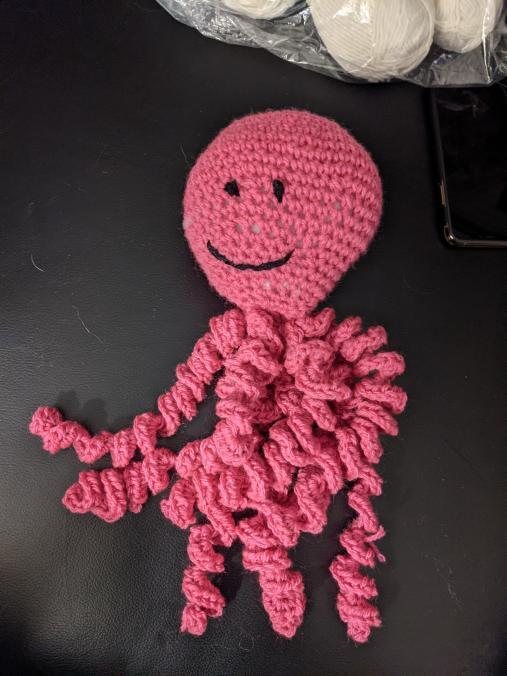
2021-02-04
These two photos are of a recent crochet project my mom just completed, I just think they’re absolutely adorable – they remind me so much of my first teddy bear from when I was a baby. I’ve been telling her that kids would love if she made more of these, we could donate them or sell some on Etsy I keep telling her – but she doesn’t believe me when I tell her that her work is amazing. I just wanted to upload this to the archive to show how my mom has coped with quarantine life, and how her creativity has exploded over these last few weeks. In a weird way it’s very sentimental to me, because it reminds me of my own childhood and the amount of love my mom gave me throughout my upbringing when she could, I just want other people to be able to feel the love that’s been poured into this object during these unloving times.
-
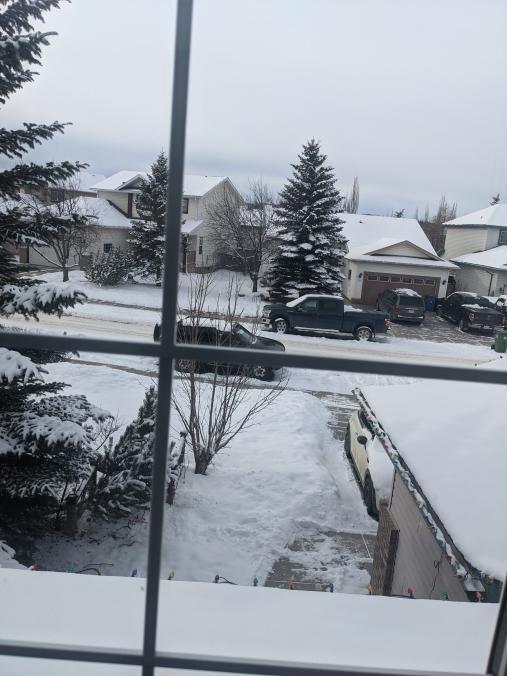
2021-02-04
This is a photo from my bedroom, and has been what I wake up to every day, and have been waking up to for the last 22 years of my life. I haven’t left my house in weeks aside from running to get groceries or a coffee. I haven’t gone out for a hike, a walk, almost nothing for these months. I’m mainly sharing this photograph to illustrate just how monotonous my life has become, and while this sounds depressing, because it is, I feel like I’m doing my part by not going out – it’s probably the only thing that’s making this bearable. All I do every day, is wake up and begin working on classwork and my internship, and then finish off with some games online with my friends, but I’ve even stopped doing that recently. I don’t really have a drive to do much anymore aside from school work. I feel even worse with the fact that I can’t find any work which would fit with my class work. So largely, I just feel incredibly useless, I take so long to get my school work done, and have little time to just do what I’d like – and on top of that I don’t even know what I’d like to do. Needless to say, this pandemic has really, really put a funk on me; class work is the only thing keeping me going at the moment, or I’d just be a potato in bed.
-
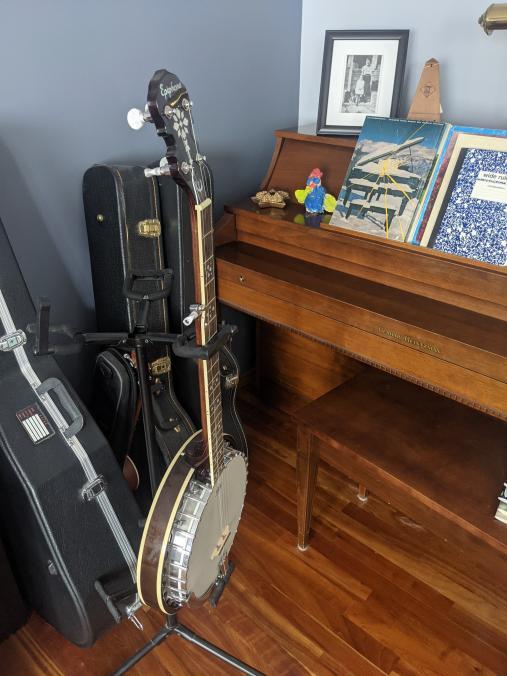
2020-06-26
During the summer of 2020, not a lot was going on in my life. I had just recently finished my undergraduate degree and had little to do on a daily basis, there were no jobs, no friends, not even family. Gradually, I got sick of just playing video games day in and out; however I wasn’t getting sick of the music of these games, many of which used the banjo. Some of these songs seemed pretty simple, and with my previous experience rudimentary experience with the guitar I figured I’d be able to some of these tunes. I started picking up my dad’s banjo, which is in the photo I provided on a daily basis; using YouTube tutorials I started to pick up the basics. In all honesty it was pretty easy to pick up, and just a relaxing experience, I even grew to like the feeling of developing callouses on my fingers? That’s a little weird but it felt like they were physical reminders of how much work I was putting into learning this new instrument. Recently I’ve kind of stopped playing, but I still love just plucking at it every now and then. My friends online similarly liked hearing me play every now and then, so in a sense it was a great coping mechanism to boredom and loneliness. However, I’ve really stopped even plucking at it, I don’t feel a drive to do much anymore; so I just kind of stare at it now every now and again, which is incredibly weird.
This item maters to me as it helped me through the initial stages of the pandemic, and helped me stay mentally active during quarantine. However, as the pandemic has dragged on I kind of have lost the desire to play it, or do much of anything else really. I’d like to add this item to the collection of performing arts as it is a musical instrument, and I would perform for my friends on Discord every now and then (but then again I’m not a professional artist or performer so I don’t think it’d be appropriate for me to be in that collection) Mental health on the other hand is a way more accurate collection for this item, as it really helped me stay mentally active during the pandemic.
-
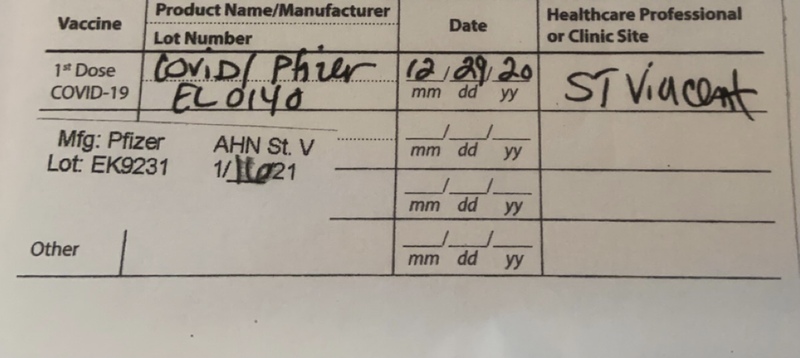
2021-01-16
Through my job, I was privileged enough to be able to receive both doses of the Pfizer-BioNTech vaccine. My first dose went fine, and I had no ill effects besides a pretty sore arm for about a day. I had heard the second dose was a little more brutal and consequently I was slightly nervous when the day came. As a pharmacy intern and pharmacy major, I am a proponent of the vaccine (and all vaccines) and was excited to receive it. Also, as a college student I am ready for life to go back to as normal as possible. Virtual education is undeniably more difficult, and I saw the vaccine as a step in the “normal” direction.
My boyfriend drove me up for the second dose and as I had heard helped, I took two ibuprofen tablets before going in. The first thing I noticed that was different was the shot itself. Quite honestly, the second shot HURT. The first one was just a pinch and analogous to a normal vaccine. The second shot was immediately more painful, and my arm was bleeding. The pain quickly passed as I sat for the 15 minutes of observation afterwards. I felt okay, went home, and proceeded throughout my day normally. I was relieved that it had gone well…until that night.
As I tried to go to bed that night, I noticed my stomach was not feeling well but I figured I would feel better in the morning. Shortly after, I began to shake violently. I had such bad chills and could not go to sleep because I was shaking so badly. My muscles began to ache as time went on, but I could not control them. In the morning I noticed I had bruises. The arm I got vaccinated in throbbed and I began to feel very nauseous. These symptoms went on for hours and I did not fall into a restless sleep until 3am.
The next few days I gradually felt better, but I barely left my bed. Luckily, the semester had yet to start so I could afford to have some lazy days. I felt so fatigued and just off. The arm in which I had been vaccinated remained bruised and painful for just over a week and my lymph nodes became quite inflamed. All of these symptoms are normal after receiving the vaccine, according to a pamphlet about the Pfizer vaccine given to me during my first dose.
After two weeks I felt completely normal, but I wish I would have known what to expect after the second dose. I do not want my story to make people afraid of the vaccine because if I could go back, I would still receive both doses. The symptoms I experienced were no joke though, and I was not expecting to be hit as hard as I was. No vaccine has ever impacted me like that, and it was a rude awakening for my immune system. I have since come to find out that I am not alone in my symptoms and that about 70% of people have similar symptoms after receiving the vaccine. I am slightly concerned about the long-term effects of the vaccine because obviously these effects have not been studied. However, I am thankful I had the opportunity to receive the vaccine, and I am also thankful I had this opportunity to share my experience with it to hopefully help others feel more prepared should they choose to receive it.
-
2021-02-06
January 2020 was going to be my year. I had gotten an internship in Pittsburgh, PA that only selected 200 kids out of the thousands of applicants. Not only did I get the internship, but I got it on the unit I wanted to be on, the Emergency Department. March of 2020 comes along. The pandemic has now hit the United States, and everyone panics. May of 2020 comes along. Still in quarantine and in lockdown. I had been out of my job for the past 2 months and was about to begin my internship. Although I was excited to get back to work, I never imagined that it would be as brutal as it was.
Every morning at 6:30 am we would get screened at the door. Masks were given out, temperatures were taken, and the three health screening questions were asked. At first, no one came to the hospital. Everyone was still scared and didn’t want to come to the place that held confirmed COVID-19 positive patients. This lasted about a week. Then everyone began coming. Before we knew it we had more patients than staff and we didn’t have enough beds for everyone coming in. Patients would come in with a broken foot and next thing you knew they were COVID positive. Did we wear our mask properly around them? Did they cough on us? Did we maintain 6 feet apart? These were all the questions rambling through our heads once we had learned that a patient was positive after taking care of them all day under standard precautions. We didn’t have enough N-95 masks for everyone to wear, so you had one and that’s what you used all the time. The amount of PPE (personal protective equipment) was far less than we needed. The hospitals tried their best to get them, but sometimes we had to make do without it. At the time, not everyone could get swabbed. We didn’t have enough it’s for everyone so only those that had 3 major symptoms (fever, sore throat, body aches). This was before we knew the asymptomatic patients were so high in number. Every day we wore our masks for 13 plus hours. Every day we wore gloves and gowns for 13 plus hours. Every day we put our lives at risk to save everyone else for 13 plus hours.
This is only a snippet of what healthcare members saw throughout this pandemic and are still seeing today. Within 4 months, I was burnt out from the pandemic. I graduate in May and I fear to see what the hospitals will be like then. In better words: wear your masks, get vaccinated if possible, and follow the guidelines. It may not harm some of you personally, but it is hurting your healthcare professionals every day that this pandemic lingers.
-
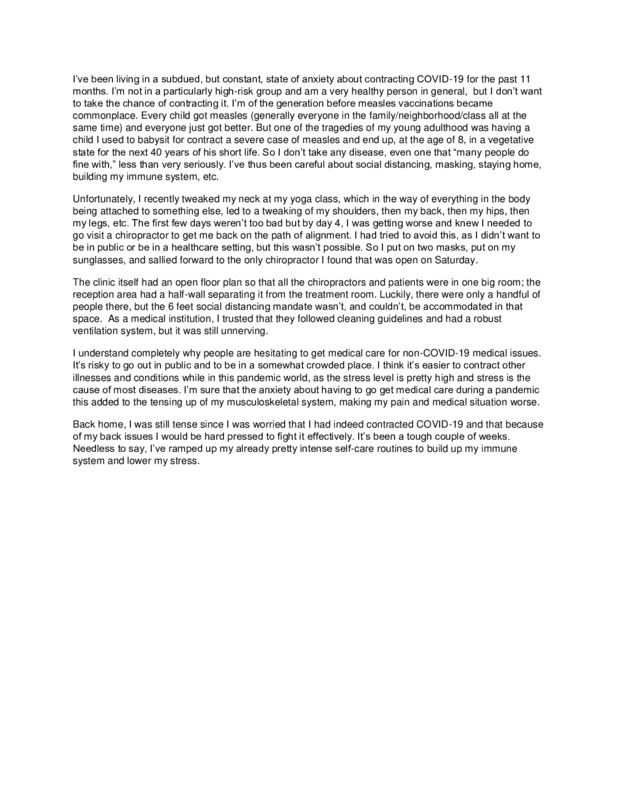
2021-02-05
I recently have struggled with a medical issue related to my back, quite possibly brought about by the stress of the pandemic. Getting sick during a pandemic is not only more common, due to stress, but also unnerving as you must go out to medical appointments, be around sick people, and worry about your sickness interfering with your body's work in fighting off the COVID-19 virus.
-
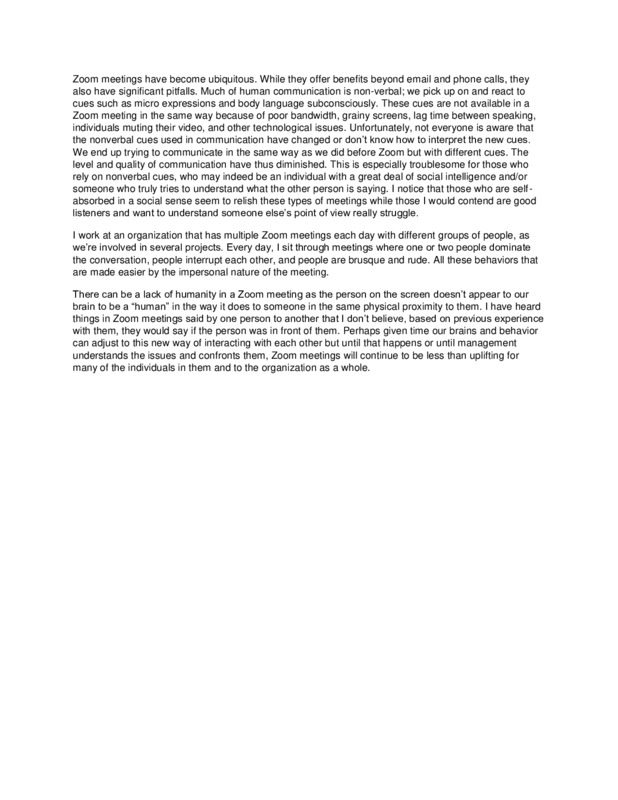
2021-02-05
With the increase in teleworking due to the pandemic has come an increase in Zoom meetings. These meetings have proven to be almost inhumane in my mind, as it's very difficult to communicate with others without nonverbal cues and people use the impersonal nature of communicating over a screen rather than in person to be pushy, rude, and self-absorbed. Although the pandemic will end one day, Zoom meetings will probably still be prevalent and lessons must be learned about how to make these meetings polite, uplifting, and productive.
-
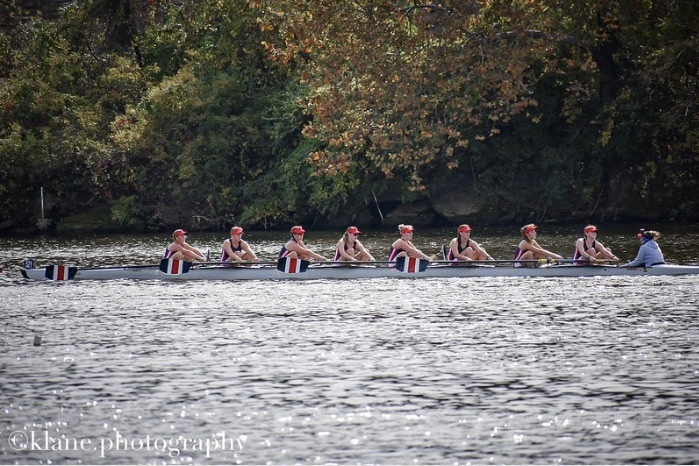
2020-03
The end of my freshman (2019-2020) spring semester of college was cut short due to the COVID-19 pandemic gradually growing more and more. Not being able to have a normal freshman year and sophomore year (2020-2021) was not what I was expecting going into college. I have always expected my college years to be full of fun times and rowing but instead they have been full of the COVID-19 pandemic and online school at home. Traveling has been cancelled due to the pandemic which is what stopped studying abroad chances in different countries around the world. Not only was my college years cut short but also my college rowing career as well. Freshman year the spring season was cancelled due to COVID-19 as well as my sophomore fall season and maybe spring. The spring break has been cancelled for the school due to the pandemic which meant the teams spring break training has been taken away which is where we get into racing sprint pieces on the water. Being able to race and perform in regattas at a collegiate level is something I have always looked forward to throughout my high school years. Not being able to have the chance to compete against other colleges especially in the main season of rowing which is spring is something that is upsetting to myself, the rest of the team, and the rowing community. Having limited rowing opportunities for practice such as small boat rowing, small group pods, and the location. Strict policies from the athletics department have been guiding what we can and cannot do for rowing. There are plans for my sophomore spring season of competing against other college rowing teams if the COVID-19 pandemic begins to decline. If the pandemic begins to decline it will lead to less policies enabling the team to practice as a whole team and in bigger boats like 8s and 4s. This will allow the teams to practice at a higher degree on and off the water to become ready to compete in the regattas. The picture that I have attached is from my fall season of freshman year when there was no pandemic going on. I picked this picture because it is special to me because my collegiate rowing season has only been a semester long. Wishing that my next two years of rowing will be COVID-19 free and full of races and regattas. Hopefully the vaccine will help fix the pandemic and move towards the future into a COVID-19 free life.
-
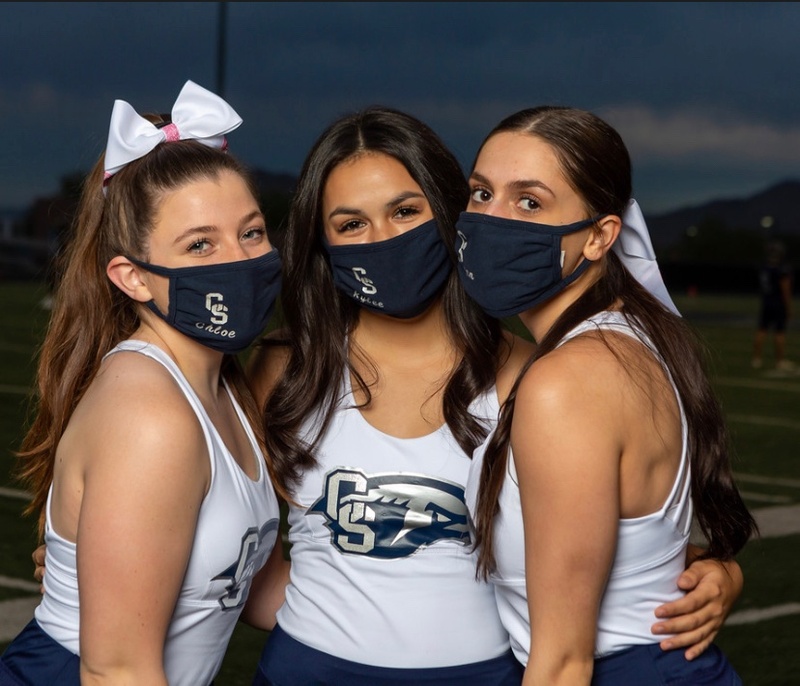
2020-11-13
Fall high school sports in Arizona were delayed and in some cases canceled completely. My daughter, an 11th grader at Cactus Shadows High School, is on the cheer team and was disappointed not to have her usual, very full cheer season. Football games finally were allowed to happen, and four home games were put on the schedule. They ended up only playing 3 due to quarantines with both our own team and opponents, and they were allowed to attend one away game. Our school is also known for a very rowdy and fun student section, so it was sad to be at the game without students in the stands, and only four spectators per athlete. At least they got to cheer- even in masks- and got some semblance of a football season.
-
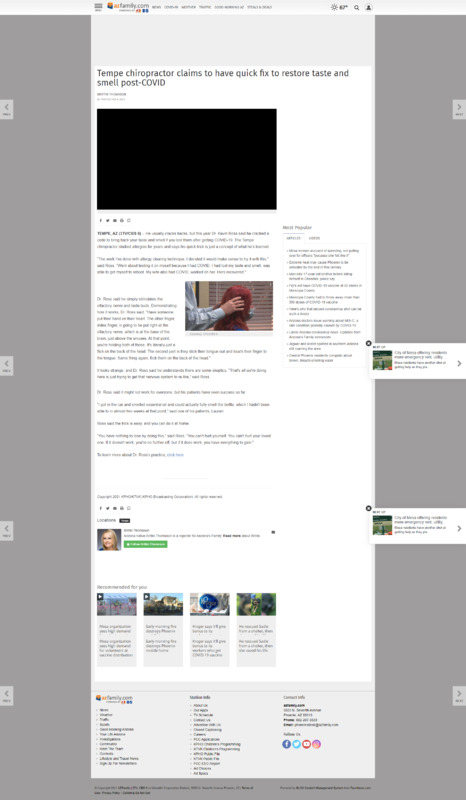
2021-02-05
A local Tempe chiropractor claims he found a fool-proof way to bring back the taste and smell of people who were once infected with Covid.
The article states, "Dr. Ross said he simply stimulates the olfactory nerve and taste buds. Demonstrating how it works, Dr. Ross said, 'Have someone put their hand on their heart. The other finger, index finger, is going to be put right at the olfactory nerve, which is at the base of the brain, just above the sinuses. At that point, you're holding both of those. It's literally just a flick on the back of the head. The second part is they stick their tongue out and touch their finger to the tongue. Same thing again, flick them on the back of the head.'"
This process has not been reviewed and Dr. Ross stated it might not work for everyone.
-
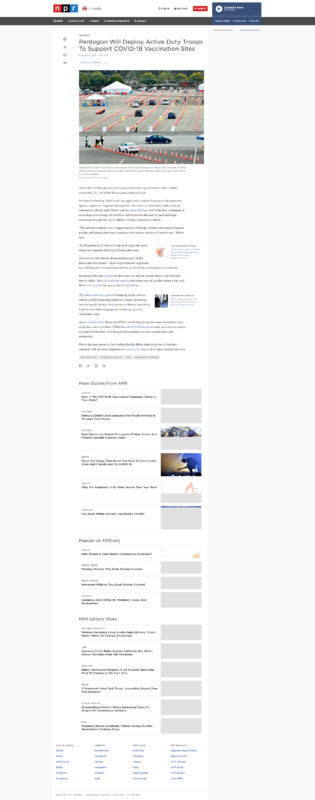
2021-02-05
The White House announced that 1,000 troops will be deployed to California in the next few weeks to aid with the vaccine roll out process. This is a single part of the Biden administration's "whole government" approach to ended the virus. The administration is already setting the goal of 1 million doses per day and may up that to 1.5 million.
-
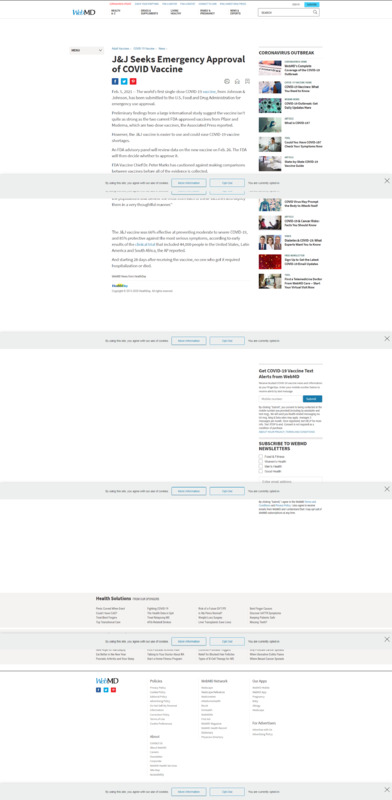
2021-02-05
Johnson & Johnson has submitted a request for emergency approval of their single dose vaccine. As the current vaccines require two doses, this would, in no doubt, help speed up the vaccination process. The down side is that this vaccine is around 30% less effective than the current vaccines.
-
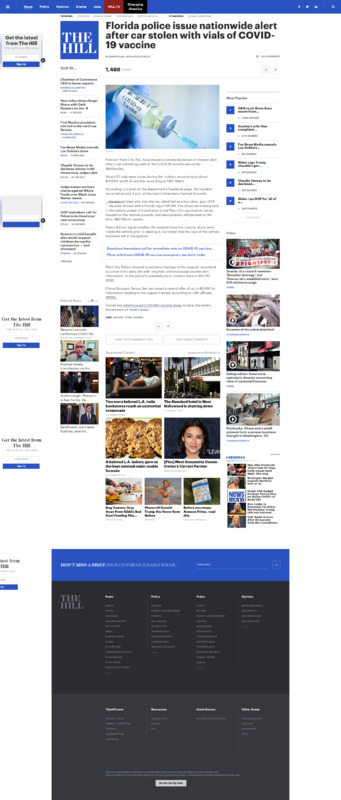
2020-02-04
A car was stolen in Florida containing up to 30 vials of the Covid-19 vaccine, worth around $10,000. Police issued a nationwide alert, and do not know if the suspect knew they were in the car or not. Only in Florida.
-

2021-02-05
In a 51-50 partisan vote, the Senate Democrats inch towards passing President Joe Biden's $1.9 trillion dollar relief package. The vote enables Democrats to move forward without fear of a filibuster blocking. There was little bi-partisan effort, but Senators Joe Manchin (D-WV) and Susan Collins (R-ME) were able to strike a deal preventing high-income earners from receiving a $1,400 stimulus check. The bill is most likely to pass later this month after the Senate impeachment trial of former President Donald Trump is over.
-
2020-02-05
There is a Sprout's less than 2 miles away from my house. My parents would often go to buy fresh produce and snacks from the bulk section. Due to the pandemic, Sprout's no longer offers their self serve bulk section. Instead, there are prefilled bags. My parents no longer frequent Sprout's, I think because of this new policy, or perhaps better prices elsewhere.
Because my close friend works at Sprout's, I visit her at work. With the exception of the bulk section, everything is still the same. However, I do see the curbside pickup and grocery delivery options being used more. My local Sprouts has designated some parking spots for curbside pickup. One time when I was visiting my friend, she was on Instacart (grocery delivery) shopping duty that day. I walked around with her around the store as she picked up the items that the customer requested. She had to be very quick and find the items immediately. Not only that, but if the phone beeped, she had to drop everything she was doing to deliver a curbside order.
Being an essential worker in customer service is very hard work. I hope that people can acknowledge and appreciate their hustle.
-
2020-02-05
Costco is my absolute favorite place. It genuinely makes me so happy. Even going during the pandemic makes me happy. However, Costco is definitely not the same as pre-pandemic. Obviously, there are no free samples anymore. This is because it would be a health concern. Although I will miss munch and shopping, I understand that this cannot be expected during a pandemic. As of now, they have the free sample stations up but with just a display of the food. I know that the free sample employees are contracted by Costco. I haven't seen some of the familiar faces recently. This makes me worried, I hope they are still doing okay during the pandemic. I know that Costco cares about their employees, so I hope they found away for the free sample people to still keep their jobs.
Another change I've noticed in my local Costco is the food court. The food court is Costco's loss leader, the delicious and extremely affordable food lures customers in and in turn makes them shop. Due to COVID, Costco's food court menu has been severely shorted. Fan favorites, such as the $1.50 hotdog with a free drink, chicken bake, and pizzas are still available. However, they are not the same products anymore. The hot dog, although still delicious, has a smaller bun. The chicken bake is completely different now. It looks more machine-made, and according to my father, does not taste the same. This really disappoints me, as the chicken bake is my absolute favorite item on the menu. The pizzas are only offered in cheese and pepperoni; the combo flavor has been kicked off. This also disappointed me because I only like the combo pizza. In addition, there are self checkout kiosks where you order and pay, then go up to the window to pick up your food.
Other than the food, Costco is still the same. I think life will only be normal again for me when I can go to Costco on the weekend, shop and nibble on the free samples, and still leave room for a chicken bake and combo pizza to go.
-
2020-02-05
I often feel naked without a mask now. Sometimes I get the same scare of losing my mask that I get with my cell phone. It is without a doubt that masks have become an important motif in our pandemic-lives. I wanted to share some random struggles of wearing a mask. They are only minor inconveniences, but I think they provide excellence context to the current lifestyle.
-Glasses fogging: Glasses wearers often find their glasses fogging up whenever they breathe with a mask on. Luckily, this is an easy fix. As long as the glasses are fitted over the mask, there should be no fogging. Sometimes the mask has to be pulled up a bit higher on the nose to achieve this. There are also sprays that prevent glasses from fogging.
-Makeup: People who wear makeup often find the undersides of their masks smudged with foundation, concealer, blush, lipstick, etc. Some people opt not to put makeup on the bottom half of their faces to prevent this problem, others just embrace the makeup smudges.
-Acne: many (typically young) people who wear masks for a prolonged find acne around where their masks were. This makes sense, as sweat and moisture collects in the mask. Proactive skin care, such as washing the face with a gentle cleanser or other acne-treatment solutions can alleviate this issue. I personally see this as a non issue, as no one can see the acne anyways because of the mask!
-

2020-05-11
Canadian Shield is a company that makes face shields. They released this video showing the process.
-
2020-02-05
The other day I went with my dad to the State Farm Stadium vaccination site in Glendale and he got his 2nd Pfizer dose. It's amazing to know that for him the pandemic is "over", as he likely will not be hospitalized if he does contract Covid-19 in the future. As my father was my main concern being a young person, it lifts a weight of my shoulders knowing if I come back from class with Covid that I won't hurt him. Currently, he is the only one in my family, including extended, who has received it. He's apart of the minority of Americans who are fully vaccinated, hopefully the numbers will increase soon.
-
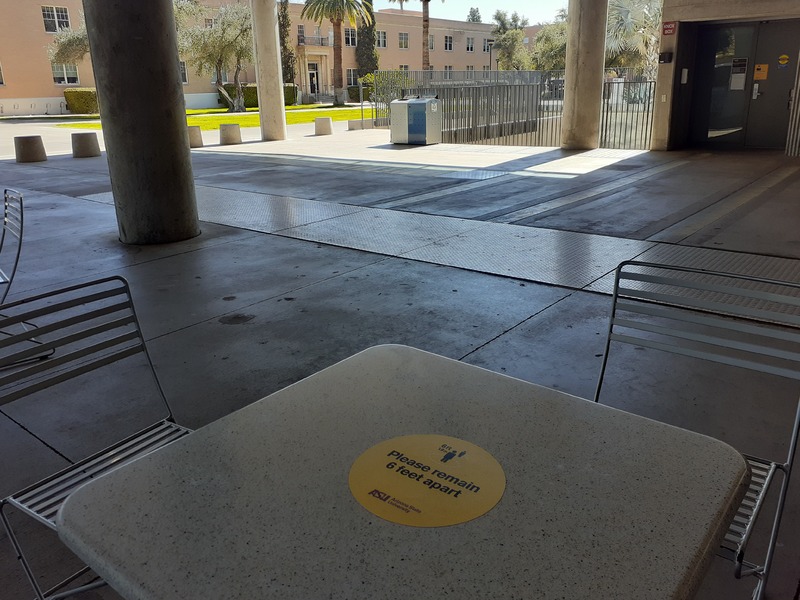
2021-02-05
This is a picture near Lattie F. Coor Hall at Arizona State University. Normally this area would bustling with students, but now, a year after the start of the pandemic, it remains empty and quiet.
-

2021-01-28
In Tennessee, the state has announced new partnerships with rural pharmacies to more effectively reach the elderly outside of urban areas. This particular article focuses on East Tennessee and the rural counties surrounding the Knoxville metropolitan area. This is great news to those who do not live in cities as Tennessee is a mostly rural state. For some elderly people, they would potentially have to drive two hours to get to the city to get a vaccine. However, because of this new partnership, it will make it far easier for those in rural areas to receive the COVID-19 vaccine.
-
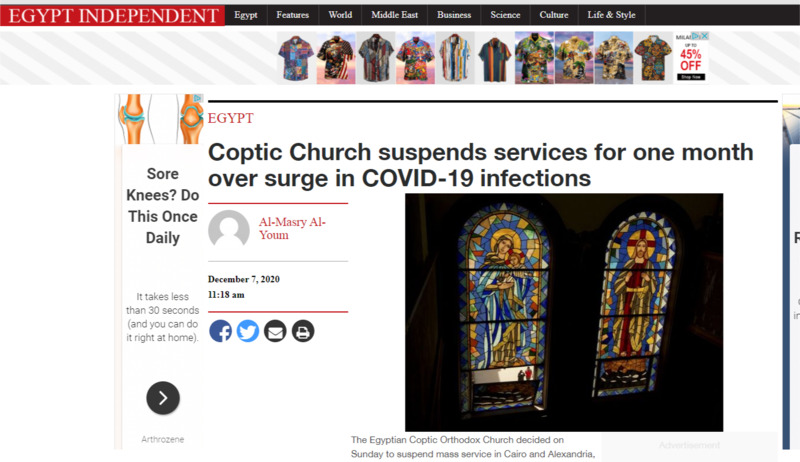
2020-12-07
The Coptic Orthodox Church of Egypt issued new guidelines in early December to protect congregants and members of the clergy. As Egypt’s second wave, the Orthodox Church in Egypt acted, working to slow the spread. While limits on certain gatherings took place to adequately social distance, most events were canceled altogether. The Church limited the number of people who could attend Mass and funerals, as well as limited seminaries and institutions to 25% capacity for classrooms.
-
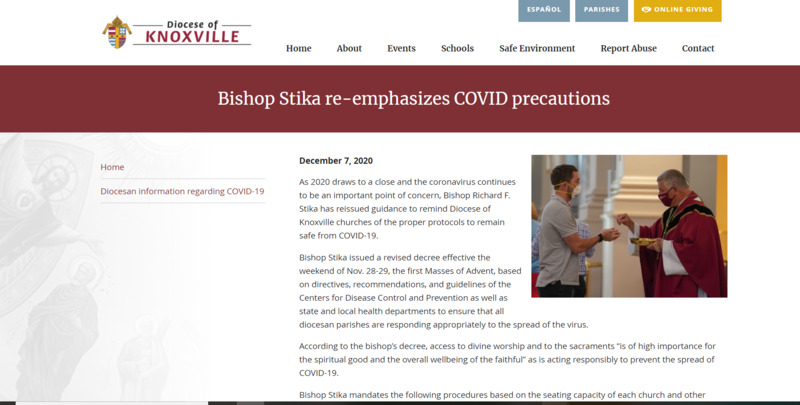
2020-12-07
As the COVID-19 pandemic rages on, Catholics continue to practice pandemic protocols. From late November through December, East Tennessee was the epicenter of the United States for Coronavirus transmissions. As a result, the Roman Catholic Diocese of Knoxville issued renewed guidelines for parishes within the diocese. The declaration makes it clear the practicing Catholics must continue to participate in the Mass. However, the Bishop was also transparent that the Church and its parishioners must practice participation in the Mass safely. This article outlines the precautions the Diocese of Knoxville has taken to continue practicing their faith while protecting one another.
-
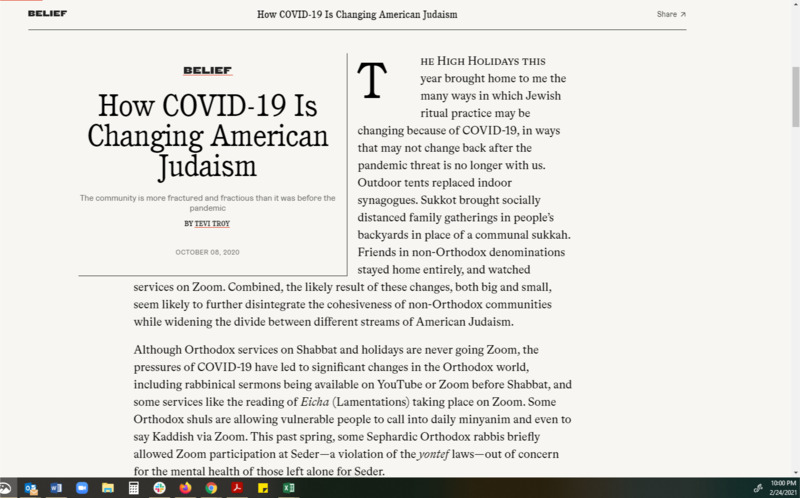
2020-10-09
Judaism in America is rapidly changing due to the COVID-19 pandemic. Historically, the Jewish community, while having various splits (i.e. Orthodox, Reformed, etc.), has continued to view itself as one, unified community. However, the pandemic has highlighted the various ways in which the community is perhaps more fractured than previously thought. For example, while the Reformed community has quickly adopted having services over Zoom, the Orthodox community, though allowing certain services to be performed over Zoom, will not allow specific holy days to be Zoomed. The pandemic is not only creating new rifts within the American Jewish community, it is bringing previously extant rifts to the fore.
-

2020-05
In this article, various Muslims outline how their faith has guided them through the pandemic. For many, faith and religion have been their guidance through the COVID-19 crises. Unfortunately, the pandemic has restricted how Muslims have been able to practice their faith. While this article is specifically written with practicing Muslims as the target audience, one need not be of the Islamic faith to learn and appreciate how the faith can aid in our understanding of the world during the pandemic.
-
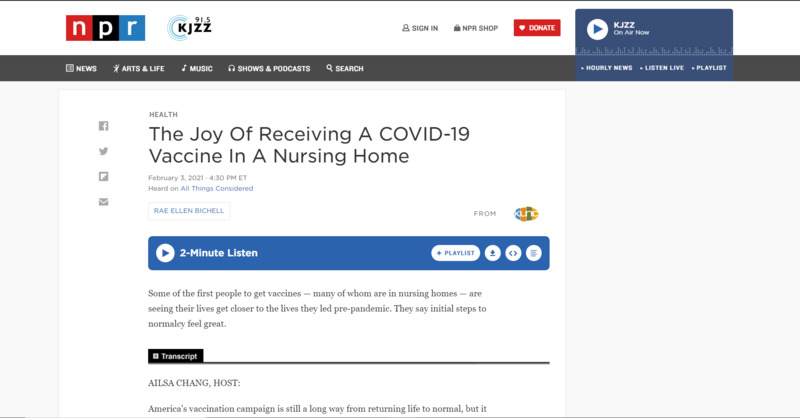
2021-02-03
Residents at a Colorado assisted living faclity got their second dose of the COVID-19 vaccine. They are now allowed to have gatherings as long as they continue social distance and wear a mask. Their family can also visit them once again as long as certain safety measures are followed.
-
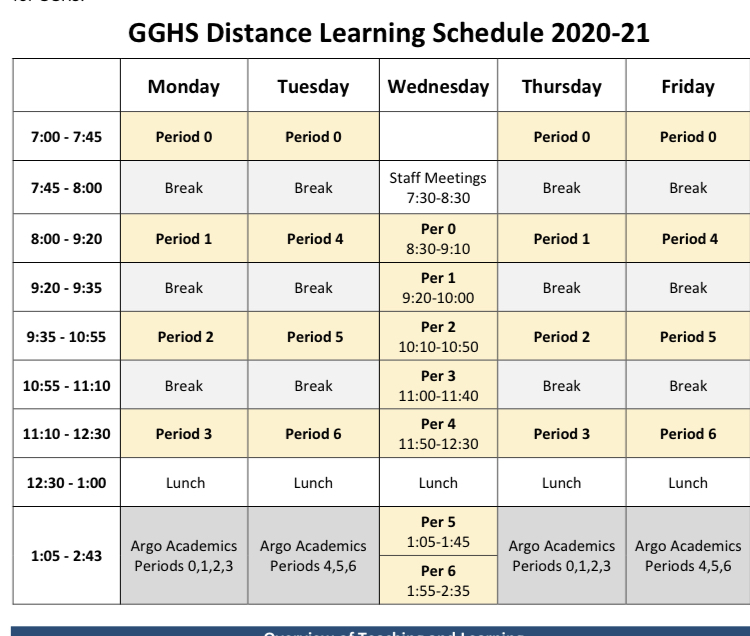
2021-02-02
When I first saw our Distance Learning schedule, I was actually relieved. When we were still thinking of re-opening back in August, the Hybrid schedule they proposed was atrocious. I would be able to synchronously (live instruction) teach a student for only 2 hours a week, the other three hours would be asynchronous. The powers that be told us “you have to just deal with the fact that you won’t be able to teach everything you usually do.” Of course, these are the same powers that be who expect the kids to pass their AP tests, and tell us that state testing (which is still happening regardless of the opening status) is “high stakes.” Contradictions, much? So, the Distance Learning schedule, which allows me to see a student three times a week, for 3 hours and 20 minutes of live instruction, was a vast improvement. Still, block scheduling? The very idea of block scheduling sent chills down my spine. Even in college, I opted for M, W, F classes because I do not sit still long enough for the 1.5-hour classes that were on T/Th. And how would I digitize an entire course? I was lucky to have already “flipped” my classroom about five years ago, when I recorded all my lectures and assigned them to watch on YouTube, freeing up class time for discussions and document analysis. But how would I do gallery walks, document analysis, Socratic Seminars, etc. digitally? Could I? Now with a semester of Distance Learning under my belt, there have been some huge advantages to being forced into this completely digitized world. First, digitized documents are amazing. So much of my course is document analysis. With digital documents, the copies aren’t blurry, the kids can zoom in if the font is small, and thanks to Google, they love to highlight and annotate the heck out of them. And Jamboards have been a godsend for collaborative analysis. I am debating whether I will ever go back to paper document analysis. Online tests have also been a game changer. I always steered away from online tests, due to fears over test security. Test days were big affairs in my class. The kids would put all their items, including phones, on the counter. I would go by each table and make them turn out their pockets to ensure no phones. I liked to joke that test days were more serious in my class than going through TSA. Because the students sat in tables of four, there were four forms of the multiple choice test and 20 versions (4 versions per period, for five periods) of the short answer portion of the test. The end of test day left me with 180 Scantrons, 180 short answer questions to grade, all with different forms, plus their notebooks, which they turned in on test day. I had to let that kind of control go this year and jump headfirst into online testing. And I am so glad this happened. It was the push I needed. The world of online testing has improved remarkably since the ten years ago that teachers at my school began to move toward it. It is SO EASY to grade and to make different forms with the click of a button. The multiple choice grades automatically and the short answer, I click the points and it pushes to the gradebook. A task that took me four hours now takes me 30 minutes. I know while the kids are at home, there is nothing to stop them from having notes on the side or on another device, but honestly, with tests that are based on historical reasoning skills, I don’t really care if they are looking up the name of an act, event, or person. I am more interested in if they can effectively use that information to support their argument. When we’re back in person, I can ensure they don’t have their phones and that Go Guardian is on to keep them from opening other windows. Without Distance Learning, I would have never made this change. Writing has also dramatically improved due to technology. I always made my students write essays by hand because the AP exam makes them write them by hand. However, with the AP exam going digital, I can now, too. It is incredible to see how the quality of writing has improved through typing. It is terrible to think that students in previous years may have been less successful on the AP exam simply because they did not formulate ideas as well with pen and pencil as they would on a computer. Block scheduling, too, has been surprisingly smooth. It is so refreshing to have time to analyze documents and follow it up with writing and peer editing - all in one period! Of course, I will be fine to return to our 55 minutes classes someday. I still don’t sit still well. Will I keep the course entirely digital when we are (hopefully) back to a normal year? Probably not everything. I miss the kids having a notebook that we build throughout the year, and will probably return to our traditional notebook for in class activities. BUT I am happy to never run a Scantron again!
-
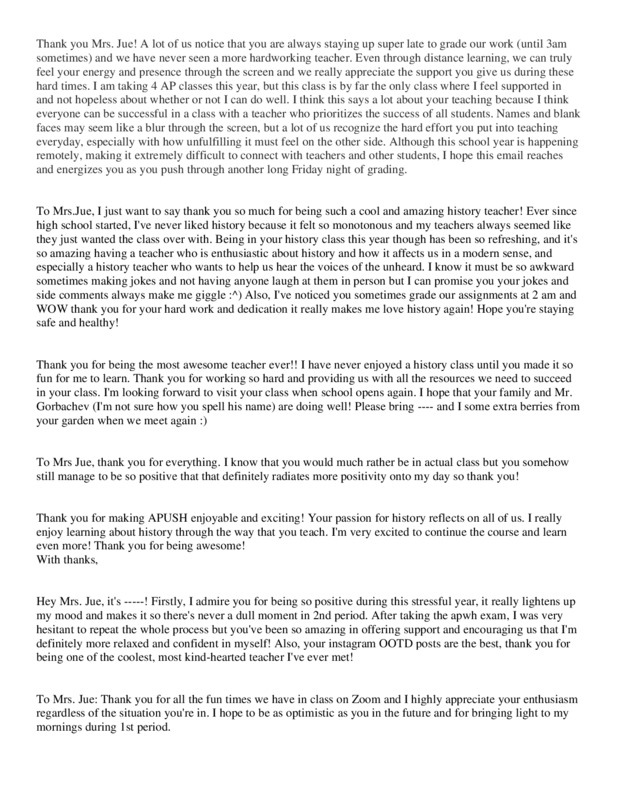
2021-02-03
It is weird to teach high school online. I usually get to know my kids by wandering around the room and making small talk. By inviting them to go running with me during 6th period (the athletic period). By running into them walking to Starbucks before an after-school review session. By leaving my room open at lunch as an alternative cafeteria. These things are not an option this year. When you teach, the jokes you make, are the kids laughing? The topics you’re really excited about sharing - are the kids excited? Are they REALLY listening when they nod at you, or are they texting their best friends out of the view of the camera, or playing a video game on a separate device? The silence is the weirdest part. Do the kids pick up on the little one liner remarks I drop in? Honestly, I get SO EXCITED when the Zoom chat lights up. It is truly my favorite part of any period because it’s like being back in class, having a real conversation, instead of me calling on students to answer and visiting them in break out rooms. They don’t like to unmute themselves to comment. Even in break out rooms they are still a bit anxious when I appear. They’re always willing to share when I call on them, so I know they’re learning the content. But I do sit up at night while I grade and wonder if the kids are actually enjoying class. I love teaching so much, and I love my kids so much, it hurts to think that this year’s kids just aren’t getting the same experience. And I am 100% in favor of staying on Distance Learning until our case rates decline, so I don’t have an agenda to re-open here. And this is why these letters I received in November are so meaningful to me. Our school ASB put out a “thank a teacher” post on Instagram, telling kids they should email a teacher and thank them. Honestly, our school has very little school spirit - ASB activities and assemblies are attended by very few students. Therefore, I didn’t think much of their social media challenge to “thank your teachers.” But then, I checked my inbox. And I became teary eyed. Honestly, I expected letters from the seniors. I was very, very close to last year’s kids. We had a great year before quarantine, and then when quarantine hit, it was like I had 180 best friends who would DM me at all hours because they were lonely, mad, sad, scared, and frustrated. And I didn’t mind because I love my kids. It’s not like I had anything else to do at 2 am the world had turned upside down. But this year’s kids have never met me in person. We don’t have the same relationship as I had with last year’s kids. So, I was so, so surprised by the number of current students, some of whose emails I have submitted (with all identifying information and names redacted) who wrote to thank me. I was hesitant to submit this at first, because I’ve never been one for public bragging, which is sort of what sharing thank you letters seems like to me. I know there are teachers who post every message a kid sends them, but I am not that person. A thank you from a kid is personal, and is something you keep but do not need to share. However, these emails are a really important part of my pandemic experience. They demonstrate to me that I have not totally failed this year. These kids who have never met me face to face, sharing such kind words, and excitement for learning history is probably the biggest personal win of this entire pandemic year. These kids will never know how much these words meant to me, and how much they motivate me to give 100%, even when we are all just within our tiny Zoom boxes. I hope with all that is within me that I can get vaccinated in time to be able to teach them in person before this year ends. They have shown over and over again this year how amazing they are, and I want to be able to be able to tell them that and thank them for that in person before the end of their junior year.
-
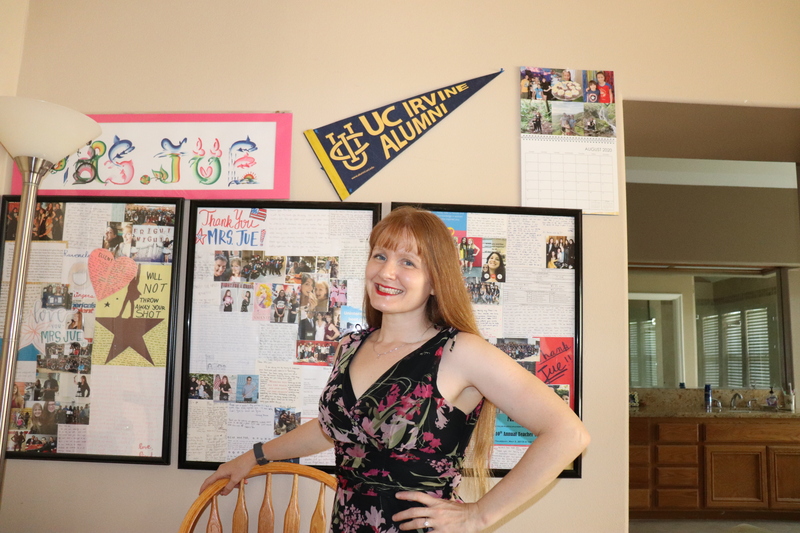
2021-02-01
I LOVE setting up my classroom for the new school year. I take great pride in making my classroom environment welcoming and comfortable. I’ve always felt that having an organized and decorated classroom helps the kids immediately know that you’re committed to them. However, with distance learning, my classroom is the corner of my bedroom. My husband has been working in the office next door since March. My kids have their distance learning set up downstairs, so that left our bedroom or the kids’ rooms. Though at first it seemed really, really strange to teach in the corner of my bedroom, I don’t even think about it anymore. The blank wall behind me though, it was really going to be a problem. I know most people have great success with Zoom backgrounds, but I have a really hard time sitting still, and I learned over the spring that I end up making my arms and head disappear because I fidget and get up and move around too much, so the virtual background just doesn’t work for me. At the very end of July, I went to my classroom for the first (and what would be the only time until November) when it was becoming clear that we might not re-open for in person instruction. When I went to my room to get the materials I needed to plan and digitize my lessons, I grabbed a few of the collage frames that hang in the front of my classroom. I ended up decorating my bedroom wall to emulate what the wall behind my desk at school looks like. It gave some normalcy to an abnormal start. In November, when it sounded like we would be re-opening, I took the pictures back to my classroom and got my room into shape. (That was a stressful day - two masks, a face shield, standing in a room I did not feel safe in and wondering how re-opening could be safe for my kids, and having a huge pit in my stomach knowing that I would not be there if we did re-open, as I had already turned in my paperwork to take a temporary leave if we re-opened). Then the county went into the Purple Tier, and re-opening was postponed. I was relieved, sad, frustrated, excited, a whole mix of contradictory emotions, because the situation was bleak but I was also able to keep teaching. Over Veteran’s Day, since my wall was now blank, I decorated my wall for the holidays. My students even sent me drawings of ornaments they make, sort of a glimmer of when we’re in person and have homeroom door decoration competitions. Winter break came and went and we remained in the Purple Tier, so I decided to redecorate my wall for January with snowflakes that my daughter and I made out of recycled materials. (A LOT of crafting has gone on these last 10 months!) This past weekend, I was startled to realize that this Monday would be the start of February. In a normal year, I make each kid a Valentine. It’s one of those things that is really dorky, but the kids actually love it. I leave a personalized one with a piece of candy on each of their seats. Many of them joke I’m their first or only Valentine. Another little bit of fun lost this year. But I like to stay positive, so I decorated my wall with hearts with their names. It may not be the personalized Valentine I usually make, but it adds some festive fun to our Zoom. I know my days of Distance Learning are coming to an end soon. The good news is our local case rates are declining, but I am anxious. My district is one of the only in the county to opt into the governor’s plan to re-open schools, lured by the promise of money and fearful of declining enrollment. Our neighboring districts have made statements that it is still unsafe and are holding out for teachers to be vaccinated. I am holding out for the same, and am dreading the repercussions that will come with taking a leave. As much as I’d love to cover the wall with shamrocks at the end of this month, I am predicting our schools will re-open by March. If I have my vaccination, I will be there for sure. However, the vaccinations are not rolling out well here, and I fear I will not have access before schools re-open. I think March is going to see me at home, without my students, staring at a blank wall, desperately trying to get a vaccine. But for now, I will find some happiness in the fact that I have already gotten dms and chats from my students joking with me that I am their first Valentine. At least some things can stay the same.
-
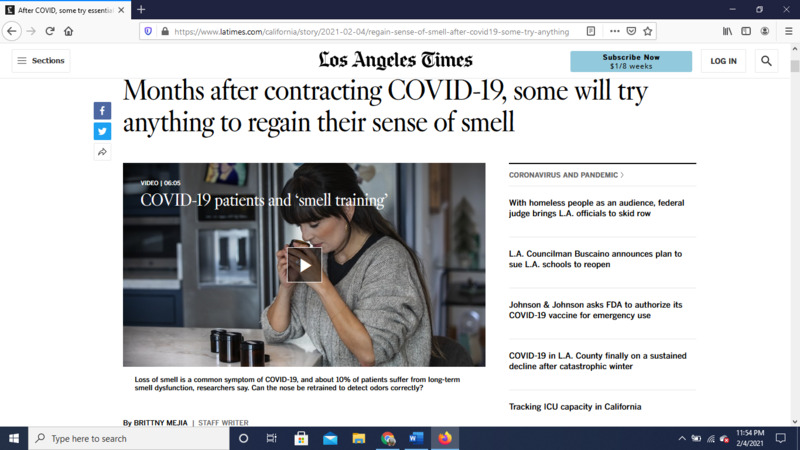
2021-02-04
When weighing the various outcomes of contracting Covid-19, the loss of smell seemed rather low on the list. Smell always ranked rather low in the hierarchy of the five senses. Sense of smell was always the go to answer in the childhood ice breaker “if you had to lose one of your five senses, which would you choose and why?” The lowly sense of smell seemed the least important. And in the Covid-19 experience, this strange symptom seemed to pale in comparison with being put on a ventilator, going in a coma, or losing one’s life. However, this article on the emotional impact of losing one’s sense of smell is a reminder that the aftermath of Covid-19, and the very ability to smell, is more complicated than one could imagine. As numerous survivors attest, the loss of smell is disorienting and depressing. It is not simply the inability to taste food, or coping with ordinary smells that are now offensive. Scents are tied to our memories, and many survivors relate losing their sense of smell to losing their sense of self. As this article explains, many survivors are turning to smell training in hopes of regaining a part of themselves that many of us never gave a second thought to prior to this pandemic.
-
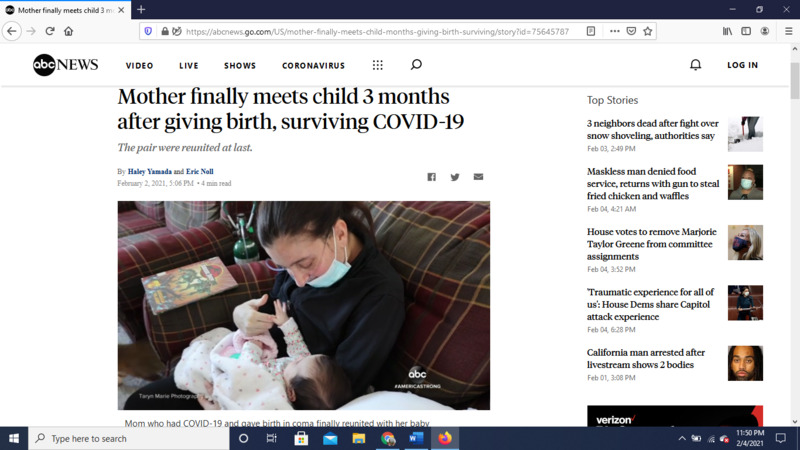
2021-02-02
As a mother of two, two thoughts have plagued the darkest corners of my mind for the past ten months: “I can’t let anything happen to the kids” and “what would happen if something happened to me?” The thoughts terrify me so much I can’t even say them aloud. So, to read about pregnant women trying to safely bring life into the world amidst the pandemic is an unbearable thought. The thought of being pregnant right now is truly terrifying, so this article struck a deep chord when I read it. A woman at the very end of her pregnancy contracted Covid-19, gave birth while unconscious, and then spent 75 days on oxygen and a ventilator. Her baby was born November 4, and just this past week, on January 27, she was able to hold her for the first time. Seeing the pictures of this mom, who I don’t know and will never meet, with her baby is a wonderful moment of hope. Clearly this family has a long road ahead, as the mom is still weak and on oxygen. However, when you see the pictures of them together, the oxygen mask seems to disappear and all I see is a mother’s love and true joy. A story of survival, and a glimmer of hope in a year that has been bleak.
-
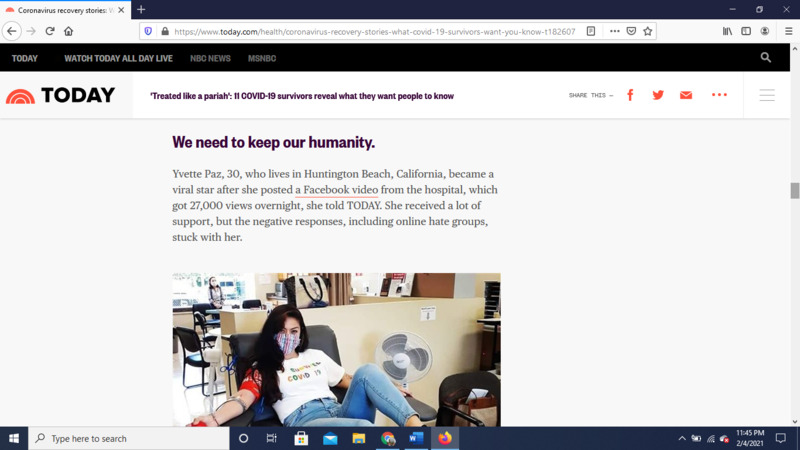
2020-05-28
This article presents the sometimes-unspoken stigma that accompanies having Covid-19. It invited survivors to share what they want people to know, because, according to the article, “for many people living through this, sharing their story is the only way they feel validated as they wait for researchers to wade through the unknowns.” The article expresses feelings of isolation from some who are avoided now that they have had Covid. Others share that there is a sense of blame thrust upon them, by those who feel as though they are at fault for getting sick. Still others disclose the subpar treatment by their health providers. Their lessons include: the disease can turn severe quickly, Covid-19 shouldn’t be about politics, don’t let your guard down, warn your friends and family, it is not just the flu, people need to have empathy, the suffering is real, be your own advocate, precautions aren’t foolproof, researchers and doctors are trying their best, and be grateful. Overall, these stories remind us that even when a person survives, they have healing yet to go.
-

2020-07-20
When Covid-19 cases began making the news in America, the stories were centered around nursing homes, where the population seemed especially susceptible. Day after day more reports of Covid-19 infecting and killing numerous patients and residents within these facilities painted a dire picture. And it is still dire. However, there are individuals who, despite their advanced age, survived Covid-19. This article from the AARP highlights four individuals in their 70s and 80s who suffered through serious cases involving long hospital stays and ventilators that made it through this virus. An interesting aspect of this article is every person interviewed ends their section by chastising people going out to restaurants, bars, and not wearing masks. Though they survived, they used this platform to try and convey the severity of the situation. As an 80-year-old female survivor from New York stated “This is not the flu. This is something that wants to kill you. It saps your strength and makes you feel like you prefer to die. This disease is such an unknown quantity. I cannot understand why anyone would refuse to wear a mask. It's a pandemic!” Hopefully, people reading survivor stories such as these will make people reflect on the choices, they are making for themselves and their communities.
-

2021-02-03
Masks are now mandatory inside middle and high schools in British Columbia, Canada. Elementary students are currently not required to. Schools are also asking for more money in order to help with improving safety for returning staff. While much of the population is currently wearing masks, the government has been relatively laissez-faire compared to the United States on compliance.
-
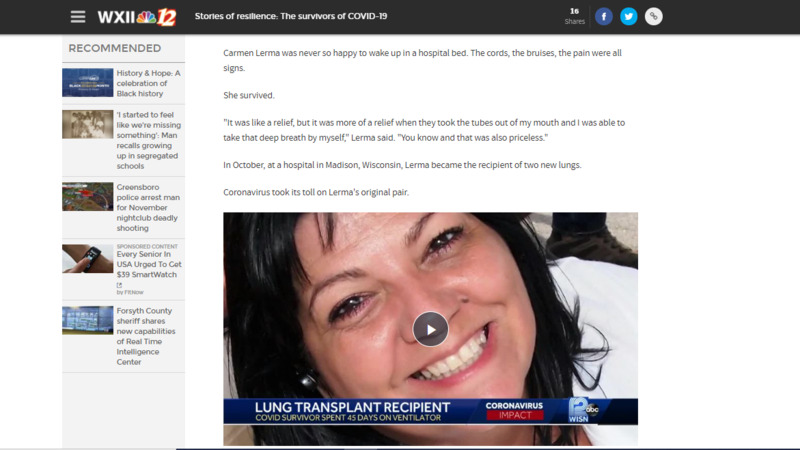
2021-01-18
As Covid-19 continues to rage and take lives, there are also the lucky ones that survive. This article shares the stories of 14 Covid-19 survivors. Though the people featured come from different age groups, races, socio-economic statuses, and geography, they all share the common experience of coming out on the other side of a lengthy hospital stay. The stories range from an infant who has spent most of his life in the hospital and has survived both a liver transplant and Covid-19, a woman who is now considered a “long hauler” with debilitating symptoms that plague her long after diagnosis, a nurse who caught the virus saying goodbye to own mother who was dying of Covid-19 and regrets nothing, a man who fought two weeks on a ventilator determined to live to see his daughter get married, and a couple who survived together and were able to celebrate their 70th wedding anniversary. These stories remind us of the seriousness of Covid-19, as one survivor states "This is not a joke. This is for real. Take it seriously. It can happen to anybody." However, these stories also remind us of the tenacity of the human spirit, the skills of the medical staff, and the hope that is still alive within this pandemic year.
-
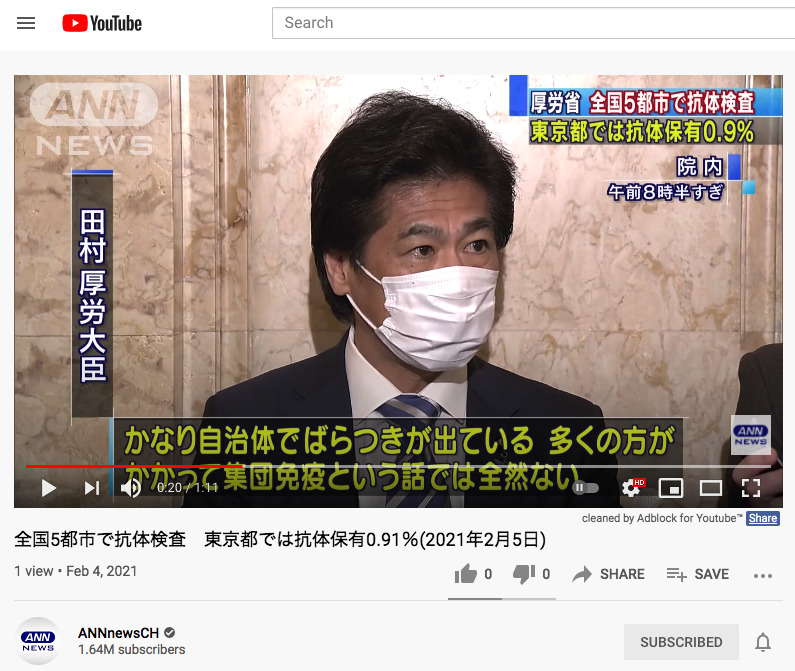
2021-02-05
This news covers the antibody rate in Japan, specifically in main cities like Tokyo, Osaka, etc. Because the rate of COVID-19 increased A LOT because people are still outside not taking social distance rules, I did expect the percentage to be higher, and it was. In trains, it is packed with people, and Japan is very analog in terms of remote working. A lot of companies still do not allow remote working plus do not change the time that the employees need to clock in and thus everyone commutes around the same time. Plus, because its winter and its cold, the trains and just local restaurants cannot open windows the whole time.
Video translated by me.
The antibody test conducted by the Ministry of Health, Labor and Welfare in five cities nationwide to check the infection history of the new coronavirus found that 0.9% of people in Tokyo have the antibodies. It has increased nine times from half a year ago. Minister of Health, Labor and Welfare Tamura: "There is considerable variation in numbers among local governments. Many people are infected and there is no herd immunity." Last December, the Ministry of Health, Labor and Welfare conducted antibody tests on approximately 15,000 people in Tokyo, Osaka, Miyagi, Aichi, and Fukuoka. Using two types of tests, those who are confirmed to have the antibodies in both tests are judged as "positive". As a result, it was found that 0.91% in Tokyo, 0.58% in Osaka, 0.14% in Miyagi, 0.54% in Aichi, and 0.19% in Fukuoka had antibodies. In the survey conducted in June last year, Tokyo was 0.1%.
厚生労働省が全国の5都市で新型コロナウイルスの感染歴を調べる抗体検査をした結果、東京都では0.9%の人が抗体を持っていることが分かりました。半年前の9倍に増えています。 田村厚労大臣:「かなり自治体でばらつきが出ている。多くの方がかかって集団免疫という話では全然ない」 厚労省は去年12月、東京・大阪・宮城・愛知・福岡で約1万5000人を対象に抗体検査を実施しました。 2種類の試薬を使い、両方で陽性が確認された人を「陽性」と判定しています。 その結果、東京で0.91%、大阪で0.58%、宮城で0.14%、愛知で0.54%、福岡で0.19%の人が抗体を持っていたことが分かりました。 去年6月の調査では東京は0.1%でした。
-
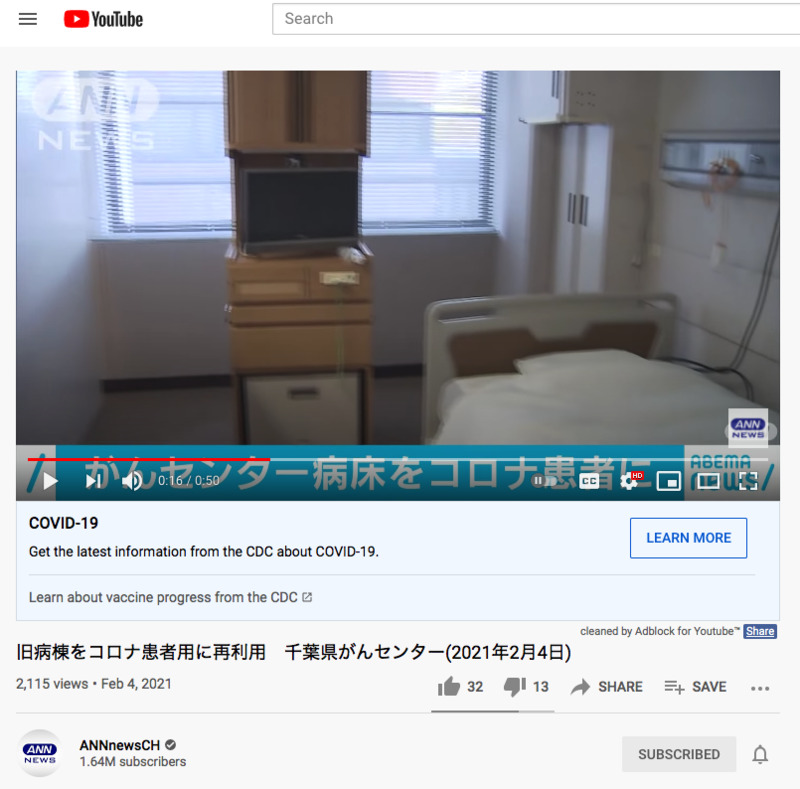
2021-02-04
This is a news of using old medical hospital that is not used for COVID-19 patients’ areas because hospitals are being packed with COVID-19 patients. This will definitely help hospitals that are overloaded. However, I am surprised that they have not started this earlier, when japan was hitting the first wave of COVID-19. Personally, Japan does take a lot of time to initiate something like this (MY PERSONAL OPINION) so maybe they had some sort of reason why they didn't do that initially.
Video translated by me.
Reuse the unused wards for people infected with the new coronavirus. It is the old ward of the Chiba Cancer Center that begins accepting patients. It was not used because a new ward for cancer was opened in October last year. In Chiba prefecture, the prefecture was becoming more overloaded, such as the occupancy rate of corona beds approaching 70%. They we will start accepting elderly people with mild symptoms from the 5th, gradually increase it, and finally accept about 70 people.
使っていない病棟を新型コロナウイルスの感染者のために再利用します。 患者の受け入れを始めるのは千葉県がんセンターの旧病棟です。 去年10月に新しい病棟ができたため使われていませんでした。 千葉県内ではコロナの病床の稼働率が7割近くになるなど医療が逼迫(ひっぱく)していることを受けて、県が準備を進めていました。 症状が軽い高齢者を中心に5日から受け入れを始め、段階的に増やして最終的に70人ほどを受け入れるということです。
-
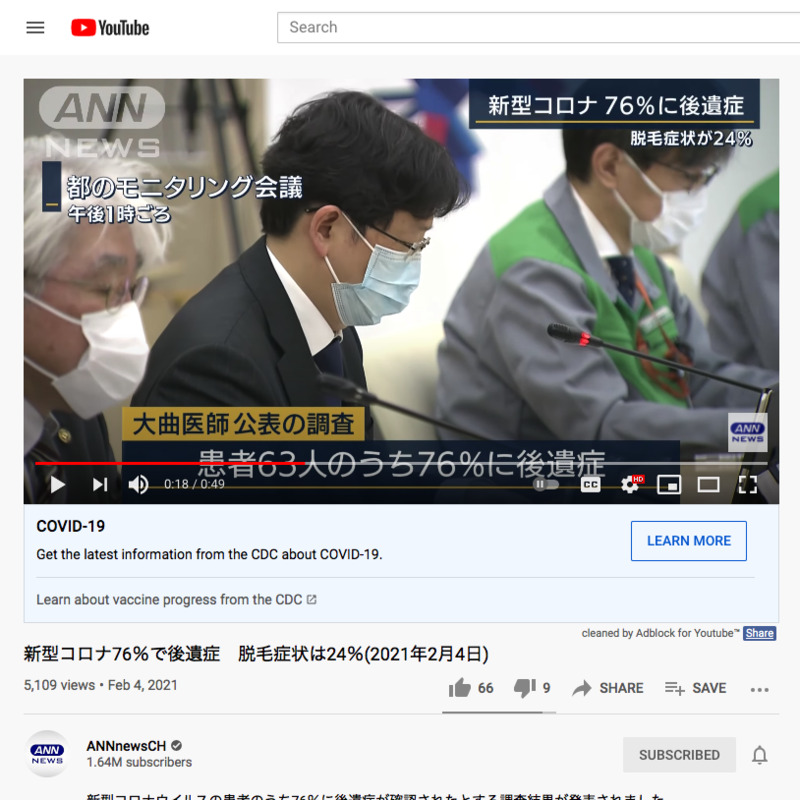
2021-02-04
This news talks about the after-effects of COVID-19, and how a lot of people still suffer even after getting being “cured” from COVID-19. I have heard some people who I know that have COVID-19 have these side effects, especially hair loss/thinning.
Video translated by me.
According to the results of a survey, 76% of patients with the new coronavirus had sequelae. According to a survey published by Dr. Omagari of the National Center for Global Health and Medicine, 76% of 63 patients had sequelae, 48% still had sequelae even 2 months after the onset, and 27% patients still felt some sort of sequelae even 4 months later after being diagnosed. Symptoms include coughing, malaise, and olfactory dysfunction, and it is said that 24% of patients had symptoms of hair loss. Dr. Omagari says the cause of the sequelae is unknown and it is important to not to get infected to prevent these sequelae.
新型コロナウイルスの患者のうち76%に後遺症が確認されたとする調査結果が発表されました。国立国際医療研究センターの大曲医師が公表した調査によりますと、63人の患者のうち、76%に後遺症が確認され、発症2カ月後でも48%が、4カ月経っても27%が何らかの症状を訴えたといいます。症状は、せき、倦怠感、嗅覚障害などで、脱毛の症状が出たという患者が24%いたといいます。大曲医師は、後遺症の原因はわかっておらず、感染しないことが最も重要だとしています。
-
2021-02-03
Last night I got my second dose of the Pfizer vaccine for COVID. I feel like it should have been easier than this.
I got my first dose of the vaccine at Chandler-Gilbert Community College, which we found out later was a county-run rather than a state-run location. Cardinals Stadium in Glendale is a state site. So the difference amounted to not getting the email about my second appointment for an anxiety-inducing long time. So when a new block opened up at the stadium, I signed up to get my second shot on the 21st day after my first, at the earliest opportunity. My husband’s appointment for his first dose is two days later.
We arrived at the stadium, got my appointment number chalked on the windshield, and wove through a maze of cones and banners toward the check-in tents. When we pulled up, the lady checked my number and couldn’t find me. She searched for my birthday and couldn’t find me. She searched by my name and couldn’t find me. She took my ID and walked off to find a supervisor. I stared at my appointment confirmation email on my phone while she did all of this.
The supervisor returns and, after asking to look at my email, handed me a clipboard. “We are going to sign you in as a walk-in, which doesn’t even exist right now. We can’t take walk-in rights right now because it’s possible that people with appointments won’t get their short today because our daily inventory is low.” That’s why my husband was not one of the lucky ones that we have heard stories about who got to get their dose early by coming along with someone who had an appointment sooner than them.
I filled out the form, the lady made me a new appointment on her tablet, and the confirmation email for an appointment slot one hour before appeared. We turned the truck back on and moved through the second maze to the next set of tents, where they covered the same questions before sending us under the second tent where a younger man gloved up, came around to the passenger door, and quickly injected me. He must have seen that we were younger as we pulled up, even with our masks on, because he said to me, “Alright, I will give you this if when I do you scream, FUCK COVID,” which of course I agreed to. But if you have had the vaccine yet, you know it goes by so quickly that I barely got out the FU.. before he said, “okay, you’re good to go.”
A third maze brought us to the line of cars waiting their 15 minutes to see if they have a bad reaction before pulling out and heading back home. I now had my second dose, and my husband has yet to get his first, so we didn’t need the help of the people milling between cars signing up people for second doses who had just gotten their first.
We got to the front of the escape line and then were released, maybe a few minutes before the 15 were really up, but we were off. My COVID card is complete. When I got my first dose, the guidance was that 30 days after your second dose is your true “good to go” date because it has had time to take effect, but in the last three weeks, that has been shortened to two weeks. I don’t know if that is smart or accurate, or if, like everything, people want this to hurry along so things can go back to “normal” after we have been at this for a year. But vaccines are still hard to get, kids can’t get it, and we don’t know how long it will be effective, so maybe we shouldn’t get too excited.
-
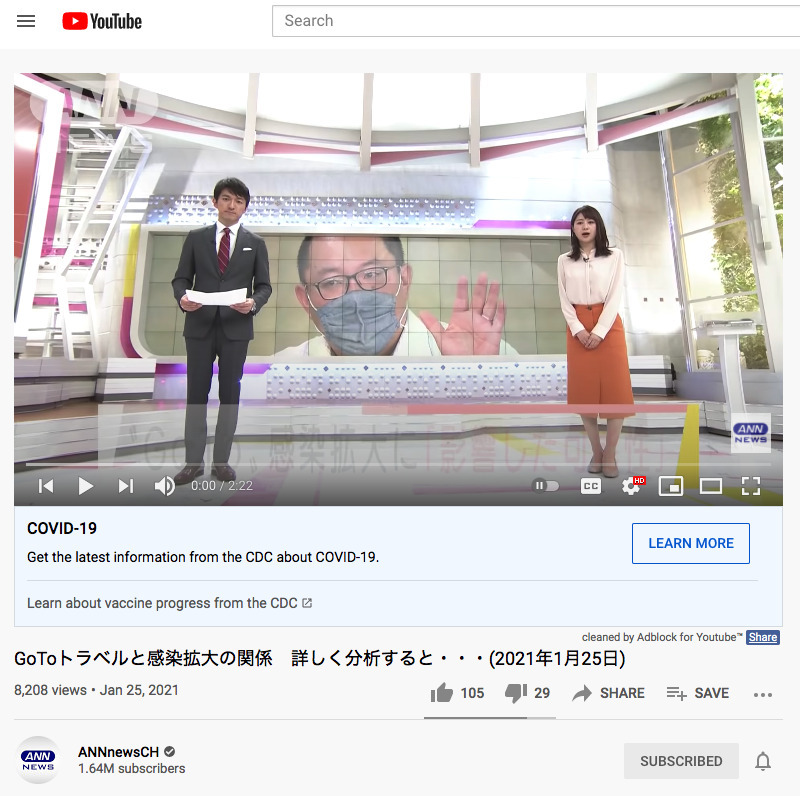
2021-01-25
This is a news that talks about the Go To Travel. Go To Travel in simple is a plan that the government set up in order for local areas to gain back the economy by supporting up to half the amount of travel fees. Using this A LOT of people traveled around Japan despite being in a pandemic. I always have thought that this traveling plan will cause more trouble, which it did.
I translated the video.
A group at Kyoto University has published a research paper stating that GoTo Travel "may have affected" the spread of the new coronavirus.
The survey was conducted by a group of Professor Hiroshi Nishiura of Kyoto University and was published in the international medical journal "Journal of Clinical Medicine" on the 21st.
The group survey analyzed about 4000 people infected with the new coronavirus in 24 prefectures from May to August last year. As a result, it was found that about 20% traveled across prefectures or were in contact with travelers.
What is interesting is the comparison of the "incidence rate" of infected people around July 22, last year when Go To Travel started.
According to the initial 5 days survey when Go To Travel started, the incidence of travel-related infected people has increased 1.44 times compared to the 5 days of the previous week. Furthermore, if the purpose of travel is limited to "sightseeing," the incidence rate jumps up to 2.62 times.
Late July last year is the time of the "second wave" in Japan.
However, the compared 5 days were also days with special conditions. That is, 4 out of 5 days from the start of GoTo were holidays and other holidays. And at this time, it was still before Go To was implemented in Tokyo.
Professor Nishiura et al. paper did not conclude that GoTo Travel was the cause of the spread of the infection, but pointed out that it may have affected it, at least in the early stages.
GoToトラベルが新型コロナウイルスの感染拡大に「影響した可能性がある」とする研究論文を京都大学のグループが発表しました。
調査は京都大学の西浦博教授らのグループが行い、21日に国際的な医学誌「ジャーナルオブクリニカルメディスン」に掲載されました。
グループの調査では去年5月から8月にかけて24の県で約4000人の新型コロナウィルスの感染者を分析。その結果、約2割が県をまたいで旅行したか、旅行者と接触していたことが分かりました。
興味深いのは、GoToトラベルが開始された去年7月22日前後の感染者の「発生率」の比較です。
GoToトラベル始まった当初5日間の調査だと、旅行に関連した感染者の発生率は前の週の5日間に比べて1.44倍に上がっています。さらに、旅行の目的を「観光」に限定すると、発生率は2.62倍にまで跳ね上がるのです。
去年7月下旬といえば、国内だと「第2波」の時期にあたります。
ただ、比較した5日間は特別な条件の日でもありました。それは、GoTo開始から5日間のうち4日が祝日などの休みであったということ。そしてこの時期、東京ではまだGoToの実施前だったということです。
西浦教授らの論文ではGoToトラベルが感染拡大の原因とは結論付けていないものの、少なくとも初期の段階では影響した可能性があると指摘しています。
-
2021-02-04
Did you go get your vaccine yet? Did you have a hard time scheduling? I'm trying to get my grandparents scheduled. Are you experiencing any symptoms? Is this your first or second dose? We will be able to meet in person soon for class now that the vaccines are rolling out... All the talk around school (Zoom) the past couple of weeks has been the vaccine. It's crazy to me that my classmates and professors (some of society's most educated individuals) ignore the fact that there are some people who don't want to be vaccinated for a number of reasons. I know that my colleagues know about the issues of distrust between the medical community and people that look like me. I, personally, don't want the vaccine because I have suffered from serious medical issues due to taking FDA approved medicines and doctors never disclosed the long-term effects and over-prescribed. I have to deal with the effects of this for the rest of my life. I don't trust medicine just because the government says it's ok to take. My personal experiences in addition to the numerous instances of medical abuse on the black body (the entire foundation of the study of gynecology, Tuskeegee, Henrietta Lacks, etc) have me refusing the vaccine. I don't have anyone around me that wants to be vaccinated or that talks about it so positively until I log on for class. But, I am also the only black person in any of my classes. I stay silent when the vaccination talks come up because I don't feel like my classmates care. They are trained to research and think critically. They know the history of abuse. Yet, they are totally blind to the fact that their assumptions that everyone will get vaccinated and the world will go back to normal are wrong. Being the only person that looks like me, I don't even want to try to defend my viewpoint because at the end of the day, I'll just be the angry black girl. When trying to move forward in life, especially in academia, you're often forced to be the silent black girl.
-
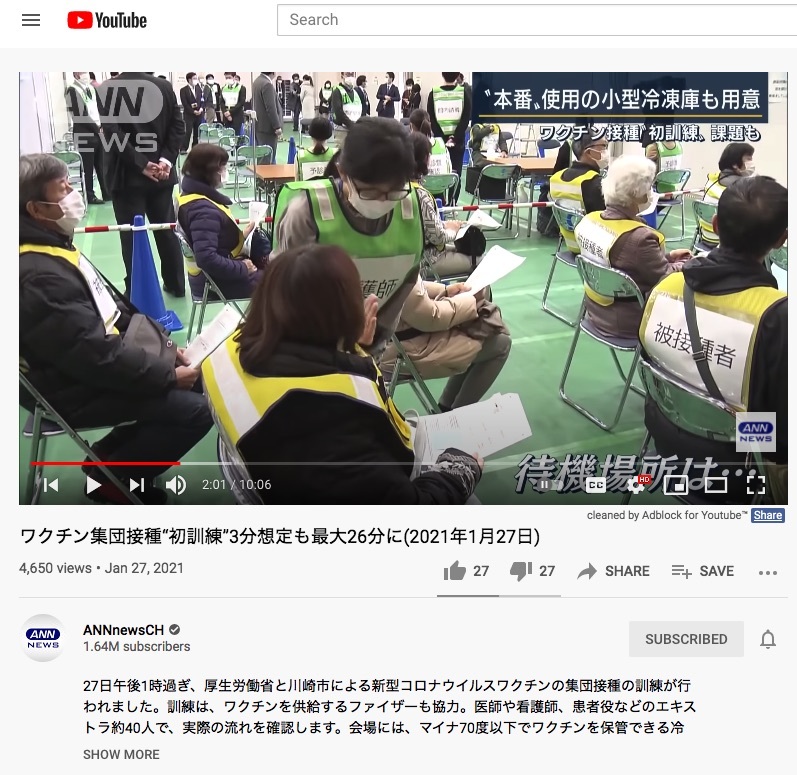
2021-01-27
This was a news video where Kawasaki city in Japan conducted a practice round of vaccination process. Personally, I do get the reason why the practice is happening; however, Japan still doesn't have a set date of when vaccinations will actually happen. This news and event itself could lead to people having high hopes of getting vaccinations soon when in reality, it could take much longer. Unlike U.S., Japan does not have a culture of drive through, meaning people physically have to go to locations for the vaccines. Also, having large gatherings like this I personally think should be avoided and maybe they should have videotaped it and posted on YouTube on how to get vaccinated, instead of many people physically going to the place and learning how to be vaccinated.
I have translated the video.
After 1:00 pm on the 7th, the Ministry of Health, Labor and Welfare and Kawasaki City conducted a training for mass distribution of the new coronavirus vaccine. The training also cooperated with Pfizer, which supplies vaccines. About 40 vounteers of doctors, nurses, and patients checked the actual flow. At the venue, there was also a freezer where vaccines could be stored at a minus temperature 70 degrees or less. The Ministry of Health, Labor and Welfare has already conveyed the message of mass distribution to each local government.
First, at the reception, complete the temperature measurement and identity verification, and fill in the questionnaire about your health condition and chronic illness. Next, a pre-examination will be conducted to see if the doctor can actually vaccinate, and if there are no problems, vaccination will be given. You will then need to wait 15-30 minutes to receive a vaccinated certificate and follow up for any side effects. According to the Ministry of Health, Labor and Welfare, it takes 3 minutes per person from pre-examination to vaccination, and if it takes 7 hours, 280 people can get the vaccine a day. However, it is said that some people took up to 26 minutes from the pre-examination to the vaccination in the training.
Kawasaki City College of Nursing, President Noboru Sakamoto: "I was a simulation patient today, but I feel like I would continue asking questions like ‘I am really scared of allergies from this vaccination’. People who are receiving the vaccination are most likely afraid so we would need to consider and adjust the fact that people will ask questions, for future vaccination sessions” the issue of selecting a venue was also pointed out.
Kawasaki City College of Nursing, President Noboru Sakamoto: "I think it's okay if it's a gymnasium, but when it comes to elementary, junior high and high schools, we use it in regular class for students. Once vaccination starts, we have to use it for at least half a year or a long period of time. Given that it is unbearable, we will not be able to use gymnasiums that are used for education every day.” Some local governments cannot prepare large venues.
In Izu Oshima, which has a population of about 7,500, we plan to vaccinate at the Oshima Medical Center, the only medical institution on the island. Oshima Town Welfare Health Division, Tetsuya Yoshizawa, Chief: "We plan to have Saturdays and Sundays, which are holiday medical treatment days, considering the system of medical staff. If that is not enough, we are considering about one day from the weekday. However, the trouble is that we have to vaccination twice. This is just new for us.” The vaccine will be shipped by ship, but the schedule may be affected depending on the weather.
Tetsuya Yoshizawa, Chief of the Oshima Town Welfare Health Division: "Of course, depending on the weather conditions, it may be canceled. If we can't see when the vaccine will arrive, it's hard to prepare.” Vaccines are first transported from warehouses that can be stored at ultra-low temperatures to hospitals equipped with freezing facilities. However, since the number of facilities equipped with freezing facilities is limited, we plan to refrigerate the facilities and transport them to each vaccination site and facilities for the elderly. The government plans to secure 10,000 ultra-low temperature freezers and aims to complete the installation by the end of May.
At a facility for the elderly in Chiba City, we have begun to consider whether vaccination can be done at the facility. This is because elderly people with dementia are admitted and it is difficult to take them to the vaccination site.
Chiba Workers Welfare Association, Megumi Kadowaki, Director of Nursing Care: "If possible, it is safest to ask a" family doctor "and inject the vaccine." However, whether the family doctor is given permission to inject the new corona vaccine is still unknown. In addition, Ms. Kadowaki wants the procedure for vaccination to be as simple as possible.
Chiba Workers Welfare Association, Megumi Kadowaki, Long-term Care Manager: "Employees are doing their best to prevent infection and protect users of the center, so I would like you to reduce the new office work as much as possible" because there are still those who cannot visit the vaccination.
Dr. Tomitsuka is visiting the clinic in Ota-ku, Tokyo. There are currently 60 patients on-site. In the middle of this month, Ota-ku recruited doctors to register as vaccination doctors for patients, including me. He says he intends to join, but he is worried about carrying the vaccine.
Director of Seseragi Clinic Tamagawa Taro Tomitsuka: "The biggest fear is that the vaccine's effect is lost after transportation because the environment of minus several ten degrees cannot be maintained. At the end, I have to vaccinate it. I am accustomed to storing and transporting the vaccine. I really want people who are used in transporting and maintaining the temperature to do it.”
It is said that cooperation with doctors will become more important in the future toward the first vaccination. Director of Seseragi Clinic Tamagawa / Taro Tomitsuka: "I think it's safer and more secure if you leave it to your family doctor, but on the other hand, it's a vaccination that requires speed, so you can involve local doctors well.” Minister Kono met with the presidents of the National Mayors' Association. Minister Kono, in charge of vaccination: "I told you that vaccination of the elderly will be after April 1st at the earliest.
7日午後1時過ぎ、厚生労働省と川崎市による新型コロナウイルスワクチンの集団接種の訓練が行われました。訓練は、ワクチンを供給するファイザーも協力。医師や看護師、患者役などのエキストラ約40人で、実際の流れを確認します。会場には、マイナ70度以下でワクチンを保管できる冷凍庫も用意されました。 厚労省は、すでに、集団接種のイメージを各自治体に伝えています。まず受付で、検温や本人確認などを済ませ、健康状態や持病などを問診票に記入。次に、実際に医師が接種できるかどうかを診る予診を行い、問題がなければワクチン接種を行います。その後、接種済みの証明書を受け取り、副反応が出ないかの経過観察のため、15~30分、待機する必要があります。 厚労省は、予診から接種まで1人3分で、7時間行えば、一日280人が、ワクチンを打つことができるとしています。ただ、訓練では予診から接種まで、最大で26分かかった人もいたといいます。 川崎市立看護短期大学・坂元昇学長:「きょうは模擬患者だったが、つい本音で『これってアレルギーが怖いんですね』とか、お医者さんを目の前にすると、そういう話が延々と続いてしまう。受けられる方は不安だろうから、たくさん質問するというものを今後、どうやって調整するか」 会場選びの課題も指摘されました。 川崎市立看護短期大学・坂元昇学長:「体育館だったらなんでもいいやと思われるが、小中高校になると、通常の授業で使う。いったん予防接種が始まれば、少なくとも半年とか、長い期間、使わざる負えないということを考えると、日々、教育で使うような体育館等は使えないだろう」 大きな会場が用意できない自治体もあります。人口約7500人の伊豆大島では、島内唯一の医療機関・大島医療センターで接種を行う予定です。 大島町福祉けんこう課・吉澤哲也課長:「医療従事者の体制等も考えて、休日の診療日にあたる土曜、日曜を予定。それで対応しきれない場合は、平日いずれかの曜日1日くらいを考えている。ただ、厄介なのが2回、接種しなければいけないというところで。いかんせん何もかも初めてなので」 ワクチンは船で運ばれる予定ですが、天候次第でスケジュールに影響が出る可能性もあります。 大島町福祉けんこう課・吉澤哲也課長:「当然、天候状況によっては“欠航”ということもある。我々もワクチンが、いつごろ手元に届くのか、その辺が見えてこないと、準備のほうもなかなか進めるに進められない」 ワクチンは、超低温保存ができる倉庫から、まずは、冷凍設備が整った病院などに運ばれます。ただ、冷凍設備が整った施設は限られているため、その後は、冷蔵で、各接種会場や高齢者施設などに運ばれていく予定です。政府は、超低温冷凍庫を1万台確保する方針で、5月中の設置完了を目指しています。 千葉市にある高齢者施設では、施設で接種ができないかと検討を始めました。入所しているのが認知症の高齢者で、接種会場へ連れていくことが難しいためです。 千葉勤労者福祉会・門脇めぐみ介護部長:「できれば“かかりつけ医”が問診をして、ワクチンを接種してしただくのが一番、安心」 ただ、かかりつけ医に新型コロナのワクチンの接種許可が下りるかは、まだ、わからないといいいます。さらに、門脇さんは、接種までの手続きなどを、なるべく簡潔にしてほしいと訴えます。 千葉勤労者福祉会・門脇めぐみ介護部長:「職員は、感染対策と利用者さんを守ることで精いっぱいなので、新たに生じる事務作業は極力減らしていただきたい」 接種会場に足を運べない人は、まだいます。東京都大田区で訪問診療を行っている富塚医師。訪問診療している患者は現在60人います。今月中旬には、大田区から患者にワクチン接種をする医師として登録するよう呼び掛けられました。応じるつもりだといいますが、ワクチンを運ぶことに不安があるといいます。 せせらぎクリニック多摩川・富塚太郎院長:「マイナス数十度の環境が保てなくて、ワクチンの効果が運搬後になくなっているというのが最大の恐怖。最後は私が打つ。ワクチンの保存と運搬は慣れた人にしていただきたいのが本音」 初めてのワクチン接種に向け、今後は、医師の連携が、より大切になってくるといいます。 せせらぎクリニック多摩川・富塚太郎院長:「かかりつけ医に任せていただければ、より安全・安心で、対処できると思うけど、一方で、速さを求められているワクチン接種なので、うまく地域の医者を巻き込んでいただければなと」 河野大臣は、全国市長会会長らと会談しました。 “ワクチン接種”担当・河野大臣:「高齢者のワクチン接種が、早くても4月1日以降になるとお伝えした。
-
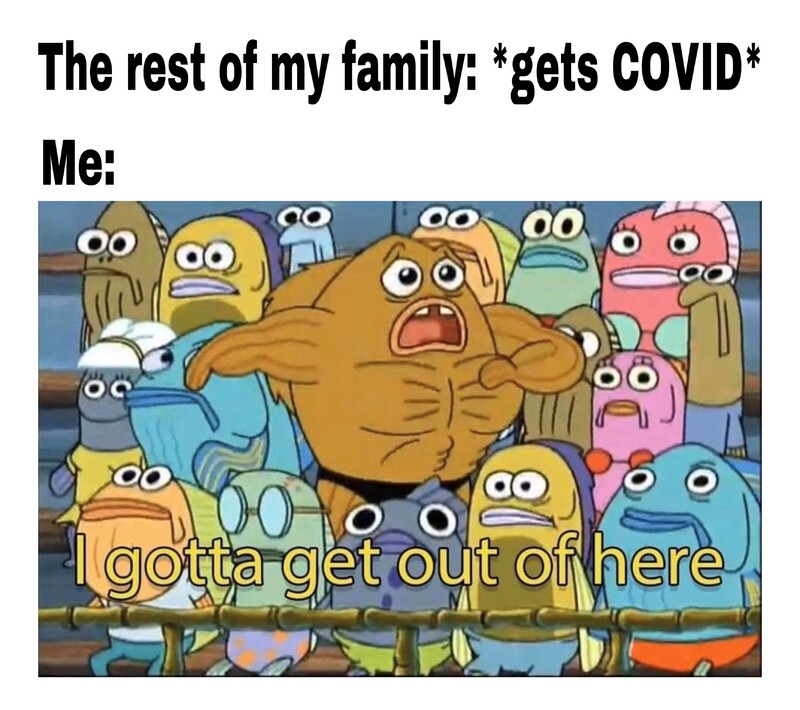
2020-12-31
Throughout the pandemic, my family and I have been extremely careful as to not catch the virus. My mother made sure my brother and I always had little bottles of hand sanitizer with us when we went to work or to the grocery store, my mom had multiple masks in the car for herself at all times, and my dad has been social distancing from people since he was born, so he was well prepared to sit in the house in social isolation. Being in PA, Gov. Tom Wolf had just about everything shut down from December 2020 to the first week of January 2021, but despite this and all of the precautions my mother had made sure we all took, my brother had brought it home from work without realizing it. We all realized we were probably going to get it when my brother was sent home from his new job after getting tested for COVID. Honestly, we were all a bit surprised it had not happened earlier, as he used to work at a hospital, but from there, we all started dropping like flies. My mother started getting symptoms around New Years Eve and my father followed suit days later. At this point, I was terrified. All I could think of is how my mother is immunocompromised and that she had it, and that I myself am immunocompromised and I would be next. Worst of all, when I am home from college, I sleep on the couch due to damage in my old bedroom, so keeping myself away from these other people in my house would prove to be near impossible (hence the meme saying “I need to get out of here”). Even if I would have been able to isolate myself, they all felt too sick to take care of themselves or one another, so that job fell upon me. At this point, I am running around the house, trying not to breathe around my family in the last few weeks that I would be able to spend time with them before heading back to school, while also stressing about having to go back to school, as well as having to quarantine for additional time after my family’s quarantine was over. A couple weeks in I start to feel the early signs of COVID, headaches, body aches, coughing, the works. I went to get tested in an absolute panic as to what this would mean for my own health and how it would affect me going back to school, only to get back a negative test. The headaches? I have migraines. The body aches? Well, I sleep on a couch where the cushions come out from under me while I sleep, so you tell me. The cough? I have a cat and a dog that I am fairly allergic to but refuse to stay away from because they are so precious. How I, out of all of my family, was able to avoid getting COVID despite being the college kid with a weakened immune system who played nurse to 3 COVID patients is beyond me. This experienced that COVID is really a gamble. You may have everything against you and not get it, or you may have done everything you could possibly do to avoid it and still catch it. Regardless, I will continue to err on the side of caution and wear my mask and carry my mother’s hand sanitizer with me.
 2021-02-06
2021-02-06 2021-02-07
2021-02-07 2021-02-07
2021-02-07 2021-02-07
2021-02-07 2020-05-15
2020-05-15 2021-02-03
2021-02-03 2021-02-03
2021-02-03 2021-02-04
2021-02-04 2021-02-04
2021-02-04 2020-06-26
2020-06-26 2021-01-16
2021-01-16 2021-02-05
2021-02-05 2021-02-05
2021-02-05 2020-03
2020-03 2020-11-13
2020-11-13 2021-02-05
2021-02-05 2021-02-05
2021-02-05 2021-02-05
2021-02-05 2020-02-04
2020-02-04 2021-02-05
2021-02-05 2020-05-11
2020-05-11 2021-02-05
2021-02-05 2021-01-28
2021-01-28 2020-12-07
2020-12-07 2020-12-07
2020-12-07 2020-10-09
2020-10-09 2020-05
2020-05 2021-02-03
2021-02-03 2021-02-02
2021-02-02 2021-02-03
2021-02-03 2021-02-01
2021-02-01 2021-02-04
2021-02-04 2021-02-02
2021-02-02 2020-05-28
2020-05-28 2020-07-20
2020-07-20 2021-02-03
2021-02-03 2021-01-18
2021-01-18 2021-02-05
2021-02-05 2021-02-04
2021-02-04 2021-02-04
2021-02-04 2021-01-25
2021-01-25 2021-01-27
2021-01-27 2020-12-31
2020-12-31